Community learning
Coming together to support ākonga and the different ways they learn
Digital boost for Pacific early learning services

Exploring successful blended learning
Licence to succeed at special careers day
8 APRIL 2024 | VOL. 103 | NO. 4
DON’T MISS OUT OUR UPCOMING EDUCATION EVENTS


27-28 MAY 2024
B:HIVE, AUCKLAND
Encouraging Passion, Creativity and Innovation to inspire leaders in education
Uncover the essence of trauma-informed approaches in schools, explore the impact on student behaviour, and learn strategies for nurturing inclusive environments
brightstar.co.nz/impactfulteacher
WHAT’S NEXT?
18 - 19 JUNE 2024, WELLINGTON
24 - 25 JUNE 2024, AUCKLAND

Prudent &
Financial Management & Governance for Schools

29 MAY 2024
B:HIVE, AUCKLAND
Sharpen your knowledge and skills and build financial foundations for effective financial managment
This insightful course offers educators the opportunity to gain a deeper understanding of school finance and budgeting, equipping you with the knowledge and skills needed to make informed decisions and optimise resource management.
brightstar.co.nz/FMS
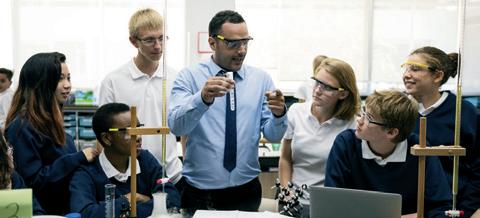
Accurate
FOR SCHOOL LEADERS LEGAL & GOVERNANCE ESSENTIALS ED10 USE CODE TO GET 10% OFF ALL TICKETS* *Applies only to May events
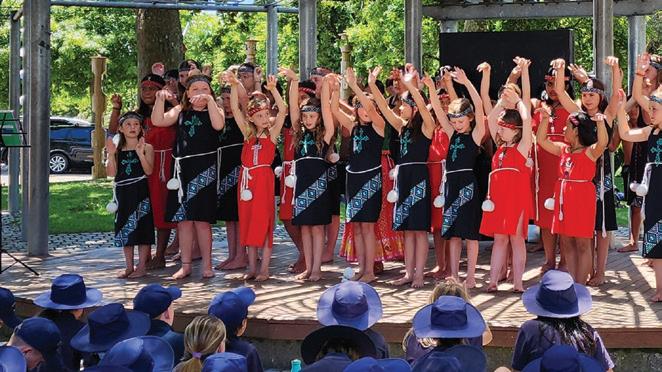
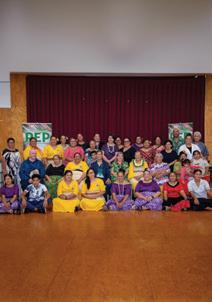



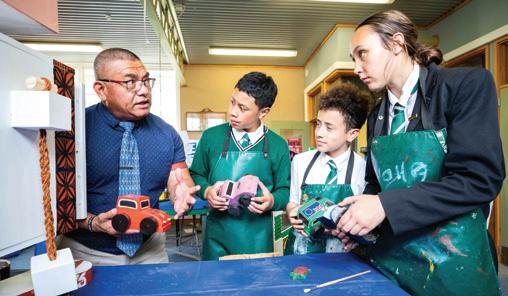
Classroom Release Time supports connection to tikanga and te reo Māori
Digital boost for Pacific early learning services clicks with communities
Exploring successful blended learning practices
Responsive teaching and learning crucial in new NCEA Level 1
20 The valuable role of animals in learning –ethically
24 Tāhūrangi – a ‘one stop shop’ for curriculum content
26 Licence to succeed: Careers day a vehicle for new pathways
30 Canterbury Pacific learners off to an energetic start with SPACPAC
34 Inspiring the next generation of women in conservation
38 Empowering equity with refreshed assessment tool

1 Tukutuku Kōrero 8 April 2024
On the cover Page 28. Hanna of Fire and Emergency NZ coaches Tamatea High School student Bailey on how to hold the hose during a careers road trip in Te Matau a Māui Hawke’s Bay. Image by Senior Constable Jason Bryant, who also transported ākonga on the day. Coming together to support ākonga and the different ways they learn Community learning Digital boost for Pacific early learning services Licence to succeed at special careers day Exploring successful blended learning APRIL 2024 VOL. 103 NO. ISSUE 103.4 Contents 4 12 8 18 20 24
Get this edition in your inbox!
Have you subscribed?
Read each new edition in your inbox before the magazine hits your staffrooms.
We send an e-newsletter alongside each print magazine, and sometimes in-between, with bonus content such as online articles and podcasts, and links to the latest notices and vacancies.


View the PLD, general notice listings and vacancies at gazette.education.govt.nz
PUBLISHED BY
Education Gazette is published for the Ministry of Education by NZME. Publishing Ltd. PO Box 200, Wellington.
ISSN 2815-8415 (Print)
ISSN 2815-8423 (Online)
All advertising is subject to advertisers agreeing to NZME. Advertising terms and conditions www.nzme.co.nz/ media/1522/nzme-advertisingterms-sept-2020.pdf
STORY IDEAS
We welcome your story ideas.
Please email a brief (50-100 words) outline to: gazette@education.govt.nz
SUBSCRIPTIONS
eleni.hilder@nzme.co.nz
VIEW US ONLINE
Web: gazette.education.govt.nz
Instagram: @edgazettenz
Youtube: youtube.com/ edgazettenewzealand
KEY CONTACTS
Reporter
gazette@education.govt.nz
Display & paid advertising
Jill Parker 027 212 9277
jill.parker@nzme.co.nz
Vacancies & notices listings
Eleni Hilder 04 915 9796 vacancies@edgazette.govt.nz notices@edgazette.govt.nz
DEADLINES
The deadline for display advertising to be printed in the 29 April 2024 edition of Education Gazette is 4pm on Friday 12 April 2024.
This publication is produced using FSC®
Certified paper from Responsible Sources.
VACANCIES NOTICES PLD
2 Education Gazette gazette.education.govt.nz
EDITOR’S NOTE
Responsive teaching and learning
Kia ora koutou!
Across our beautiful motu, educators are responding to the diverse needs and aspirations of our ākonga and communities.
In Hastings, a dedicated kaiako is embarking on a new chapter in her educational career. Harata’s transition to a full-time Classroom Release Time role is driven by her passion for nurturing ākonga knowledge of te reo Māori me ngā tikanga Māori.
Also in Hawke’s Bay, Tamatea High School students are discovering the boundless opportunities that come with a driver’s licence, opening doors to new pathways and career possibilities.
Meanwhile, in Tāmaki Makaurau Auckland, the educational landscape is being transformed by a blended learning approach. This seamlessly combines in-person, online, and remote learning experiences, empowering our ākonga to self-direct while prioritising their wellbeing and that of educators.
In West Auckland, digital initiatives are empowering Pacific early learning services to share their stories and connect more deeply with their communities, amplifying their online presence.
Being responsive is crucial for new NCEA Level 1 subjects and wāhanga ako. They are being implemented this year and give teachers the flexibility to design more stimulating and relatable courses.
Join us as we delve into these stories and more, exploring the intersection of passion, innovation, and dedication that is shaping the future of education in Aotearoa.
Wishing all school and kura kaimahi a refreshing break at the end of this term, in whatever way supports your hauora. Noho ora mai rā.
Nāku iti nei, nā
Sarah Wilson
Ētita | Editor

A New Zealand Choral Federation video series aimed at helping primary and intermediate classroom teachers foster a love of singing in their tamariki. Scan the QR code to find out more and let’s get singing!




3 Tukutuku Kōrero 8 April 2024
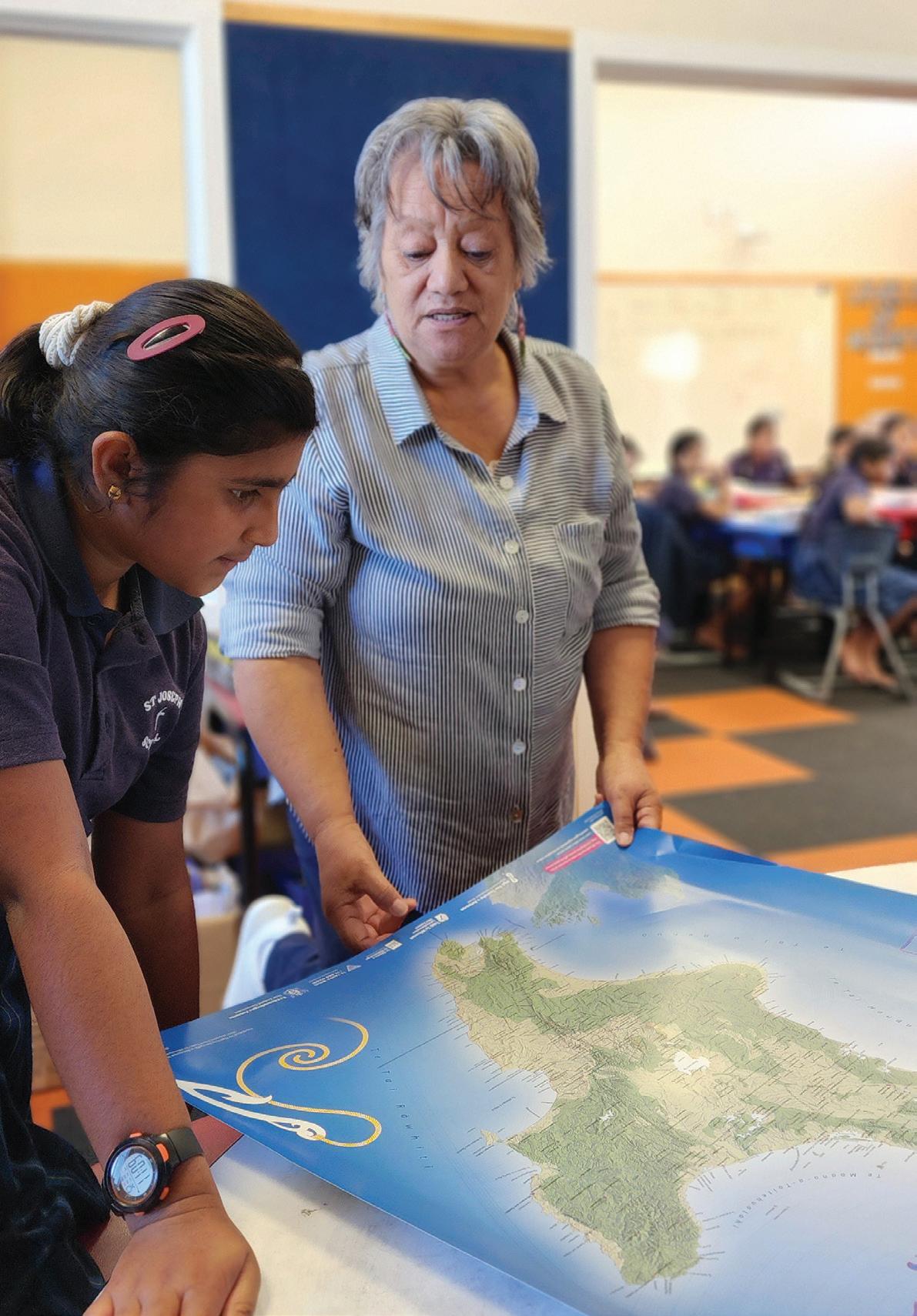 Harata in her zone, sharing her expertise on te reo Māori and tikanga Māori.
Harata in her zone, sharing her expertise on te reo Māori and tikanga Māori.
Classroom Release Time supports connection to tikanga and te reo Māori
Harata Hape, a 36-year veteran teacher at St Joseph’s School, Hastings, has switched gears from teaching in the classroom to a full-time Classroom Release Time role. The new venture has enabled her to nurture ākonga knowledge of te reo Māori me ngā tikanga Māori, a true passion of hers.
With a tremendous Classroom Release Time (CRT) built up at St Joseph’s School, principal Aaron O’Neill saw this as an opportunity to do something rich and meaningful for their ākonga.
They’ve spent the last five years developing a local curriculum, incorporating key principles such as te reo Māori, tikanga and kaupapa Māori, and most importantly Te Tiriti o Waitangi.
Kaiako Harata Hape emphasises that, “we’re using [Te Tiriti] as the waka to teach te reo, tikanga and kaupapa Māori.”
Through consultation with community and parents, they developed ways in which they could turn these concepts into actions.
Parents voiced their desire for ākonga to experience and learn Māori practices and traditions such as marae visits, preparing hāngī, planting native trees and learning about myths and legends. Most importantly, they want their children to learn about Te Tiriti o Waitangi, Matariki and Aotearoa New Zealand’s histories.
Aaron has worked closely with Harata to ensure that their local curriculum reflects the needs and aspirations of the learners and their whānau. They have a shared determination to implement and strengthen the programme to ensure it is available to current and future learners and staff.
“It’s a great opportunity. We’re hoping to build sustainable practices across the school; we want to make sure that this is set out well into the future,” says Aaron.
Collective effort and responsibility
Harata has many gifts, one of them being her love and deep knowledge of te reo Māori me ngā tikanga Māori.
Since 1987, Harata has shared this with learners, staff and whānau o te kura since she was appointed the music and kapa haka teacher.
She proclaims, “I walked through the gate with my guitar, song chart, voice and my love for te reo Māori, ready to share and express that.”
Despite being the only Māori staff member at the school, Harata has never been alone on her journey. The school staff and whānau are always willing to lend a hand when needed.
“St Joseph’s School and whānau have always been supportive of te reo Māori me ngā tikanga education,” she says.
It’s a collective effort and responsibility and having the support and guidance of staff and whānau has been a real gift to Harata.
CRT programme in action
The programme is implemented in every class during every teacher’s classroom release time. The week is divided into 11 blocks and 11 classrooms all get an equal share.
Alongside te reo Māori and tikanga, the programme bridges big concepts from the local curriculum to life and in practice.
“We’re building the plane as we’re flying it,” says Aaron.
“Your best measure [of success] is when you hear the children speak the language, and it just comes naturally in the situational context.”
Aaron O’Neill
5 Tukutuku Kōrero 8 April 2024
TE REO MĀORI

Included in this journey is Sharron Fabish from the University of Auckland who helps Harata put structure and robustness into the programme.
A key component of this support has been in the technological space, helping Harata bring her gift of knowledge into the digital formats embraced by ākonga in their learning.
Harata and Aaron emphasise the importance of creating a genuine programme that not only encapsulates Harata’s taonga but also that of local hapu.
“One of our whānau, Charles Ropitini, Pou Ahurea principal Māori advisor for the Hastings District council, is a solid hapū representative for us. He’s worked alongside and advised us throughout this journey. It required quite a lot of focus and shared determination and hard work to get it done,” Aaron says.
Through their partnership with local hapū, Aaron shares that Charles gifted their ākonga with a school pepeha.
“A part of the process in working with local hapū and iwi is we were gifted a school pepeha. It’s been woven into the curriculum as well. It’s also reflected in the art around the school.”
Aaron also shares the inclusion of some significant areas of the programme; the crossover of te reo Māori me ngā tikanga Māori and the St Joseph’s School Catholic character as well as an important link to the Aotearoa New Zealand’s histories curriculum. Aaron proudly states that their Catholic curriculum has always been inclusive of te reo and tikanga Māori.
Enabling ākonga to thrive
Staff appreciate the opportunities for ākonga made possible by Harata and the CRT programme, and they also value the programme as it covers a space that a lot of staff aren’t comfortable teaching themselves.
They believe that with Harata accompanying their journey, over time this will build their confidence with te reo Māori and tikanga Māori.
Harata is enjoying the journey and is on the constant hunt for resources and new opportunities to incorporate into the programme.
When assessing how successful the programme has been to date, Aaron emphasises, “when we talk about success, we don’t look at it as a destination but more as an ongoing journey.
“Your best measure [of success] is when you hear the children speak the language, and it just comes naturally in the situational context.”
Harata and Aaron are looking forward to exploring the goals they have for continuing this programme, including planning for their next marae visit in term 4.
Aaron expresses the importance of Harata sharing the taonga of her knowledge with the students and the positive effect on their learning.
“[I want] for the children to take ownership, for them to take over, for them to be heard. Let them talk, let them own it and be able to speak confidently and have the hunger to learn more.
“We’re valuing and prioritising this programme because it is of high importance to us. It’s just become a part of our way at St Joseph’s School,” concludes Aaron.
6 Education Gazette gazette.education.govt.nz
Ākonga at St Josephs’ School fully immersed in Māori language and culture through kapa haka.

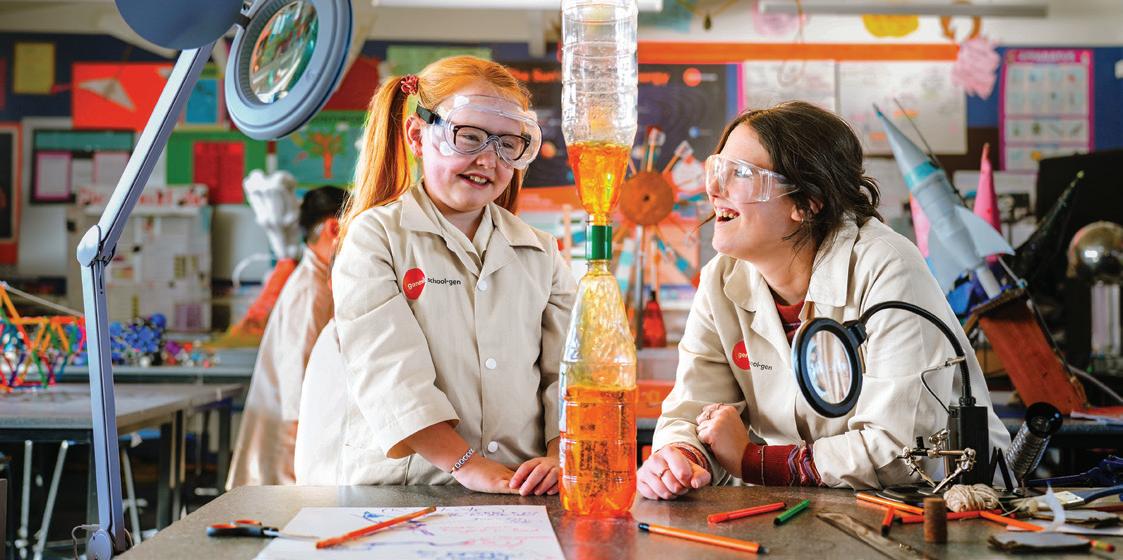

7 Tukutuku Kōrero 8 April 2024
showcasing
confidence
mana. Teach STEM with our easy-to-use resources Find out more at: schoolgen.co.nz/teachers @schoolgennz or use the QR code • STEM teaching resources including full lesson plans available online. • E-Books available in te reo Māori and English. Free PLD for teachers on renewable energy, presented by Nanogirl. NEW!
Ākonga
proudly
a haka with
and
Digital boost for Pacific early learning services clicks with communities
The online presence of Pacific early learning services in West Auckland has been strengthened through an initiative which supports early learning services to build their own website and boost digital capability.

“This website for me now is just so awesome because it forced me to market ourselves in a real professional way, and in a way that consolidates our information and who we are.”
Elisapeta Pedro
8 Education Gazette gazette.education.govt.nz
EARLY LEARNING
The team involved in the Digital Marketing Pilot after presenting their new websites. All images in this article are by JJ Paiti.
New enrolments, better communication with parents, and stronger community ties – these are just a few benefits Pacific early learning services are seeing following a 12-week Digital Marketing Pilot.
Six West Auckland Pacific early learning services took part in the Digital Marketing Pilot from 16 November last year to 29 February.
During this time, services worked with Salā Marie Young and Suitauloa Simon Young from Pacific Enterprise People Ltd (PEP) to develop vital digital skills and create a website highlighting the centres’ history and philosophy, while also showcasing their commitment to Ministry of Education Licensing Criteria GMA 1–5.
Feagaimaleata Hemopo and Amelia Ma’afu, Ministry of Education Pacific Early Learning senior advisors, say the pilot follows the completion of phase 1 of an initiative aimed at developing a seven-step digital marketing resource tool kit. It also upholds the objectives of The Statement of National Education and Learning Priorities (NELP).
“The initiative presented a way for Pacific early learning to identify Pacific ways of being, and principles of governance that may be implemented demonstrate how they may be complying to licensing criteria for Governance Management and Administration 1–5.”
Building websites and exposure
Loviana Tufulele-Lusaipau, centre manager of Akoteu Falemaama – West Auckland’s only Tongan Christian early learning service, says before the website, word-ofmouth was the main method of advertising. However, building an online presence was one of the centre’s strategic priorities.
“I’m 68 years old. I think computer literacy is important for me as the manager, and I also do the administration. I have a fair idea of what to do, but it’s just for my job. So, this was a challenge,” she says.
However, Loviana says PEP made an initially overwhelming task, more manageable.
“They really empowered me and my team to manage our online presence.”
Karen Su’a-Allison, centre manager for Hendersonbased Taulapapa Leata Su’a Aoga Amata, says a simple action like claiming the centre’s Google listing is already having an impact.
“We got more parents contacting, ringing us. We’ve had at least 10 new enrolments now – or close to 10 –since January and it’s still carrying on,” she says.
Meanwhile, Alofa Sivao, teacher and centre supervisor for Glen Eden-based Aiga Salevalasi Aoga Amata, is also seeing the benefits of the website.
“We don’t get a lot of exposure unless we have other connections in the community.
“We were sort of in a dry period with numbers, with children, last year. And now they’ve picked up again. I think the website has also helped in that sense.”
Sharing stories and history
Salā and Suitauloa say for five out of six centres involved in the pilot, there is a multigenerational aspect to them, with the second generation now taking over.
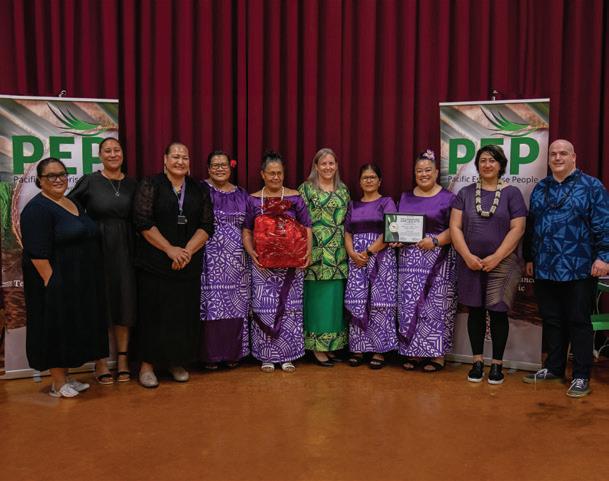
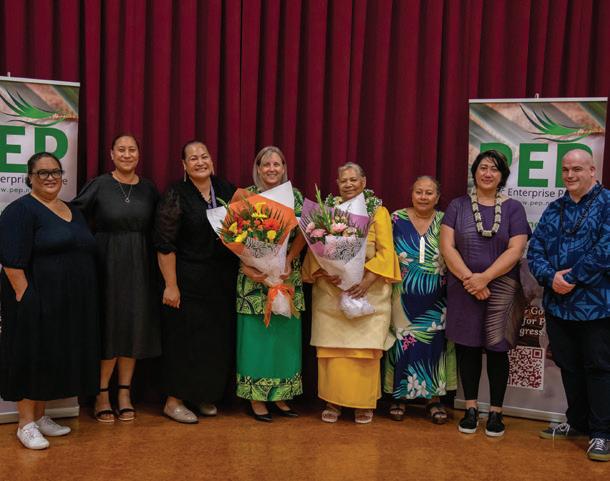
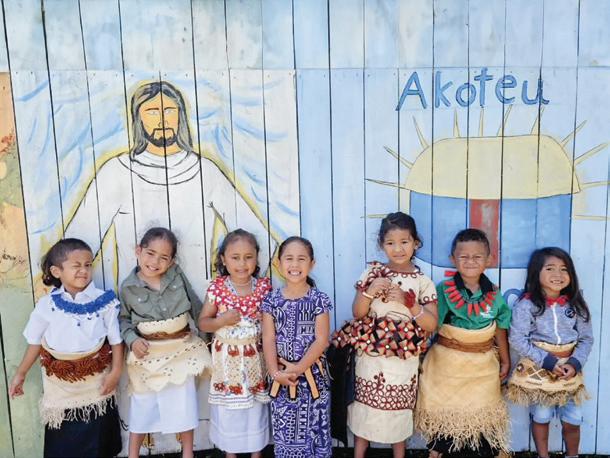
9 Tukutuku Kōrero 8 April 2024
Karen Su'a-Allison (holding the certificate) and Akelina Tuaifaiva (fourth from left) with the rest of the Taulapapa Leata Su’a Aoga Amata team at the presentation evening.
Loviana Tufulele-Lusaipau (in yellow) and Elisapeta Pedro (third from right) with the team from Ministry of Education and Pacific Enterprise People Ltd.
The tamariki from Akoteu Falemaama.
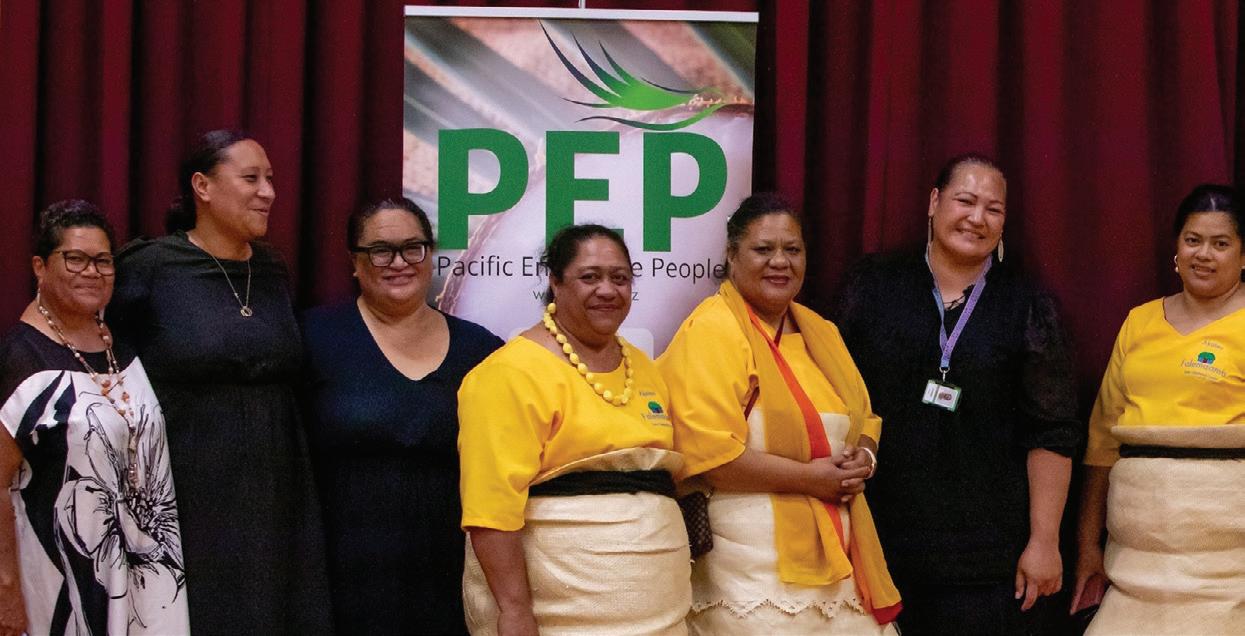
“We said, you have a story and you know the story, and the parents who send their children to your centre know the story, but nobody else knows the story. So, it’s time to get it out there,” says Suitauloa.
Elisapeta Pedro, centre manager of Fetu Fa Tokelau Akoga Kamata in Te Atatū Peninsula, is part of the second generation taking over. She is continuing the mahi of her mother, Kailelei Tepou.
She says the centre had not needed a website as they were well-known in the Tokelau community. However, it has recently rebranded by adding Peninsula Stars to its name to meet the needs of the changing demographics in the area, while still paying homage to the Tokelau values the centre was founded on.
Elisapeta says she did a lot of research when designing the website as she wanted to target it towards families who would benefit from affordable childcare.
“This website for me now is just so awesome because it forced me to market ourselves in a real professional way – in a way that consolidates our information and who we are. It consolidates our story,” she says.
Taulapapa Leata Su’a Aoga Amata is named after its founder – Karen’s mother – who started the centre as a playgroup in 1992.
Karen says this history was at the forefront of their website design.
“I don’t think our current parents know about the history. So that kind of opens the door to them having a deeper understanding of our aoga amata and how we got started.”
Akeliana Tuaifaiva, a teacher who has been involved in the aoga amata since her baby attended in 2004, says that history is important.
“She [the founder] started from nothing and now a lot of children come from university and they say they’ve started from here. So that’s the history and that’s our story.”
Meanwhile Alofa, whose parents Paulo and Ivapene Ieriko established the centre she teaches at in 1988, says the website has enabled the aoga amata to share testimonials from past students.
“Our legacy is so important – we have to sustain and we have to maintain. The testimonials from these generations were all part of the legacy,” she says.
Just getting started
The websites are just the beginning for these early learning services. Many of the centre managers and teachers say they are already looking at what they can do next.
“Now that we’ve got ourselves started on this digital marketing journey, we do hope to develop it and move with the changes,” says Karen.
“Now that we’ve got ourselves started on this digital marketing journey, we do hope to develop it and move with the changes.”
Karen Su’a-Allison
10 Education Gazette gazette.education.govt.nz

What is Pacific Enterprise People Ltd?
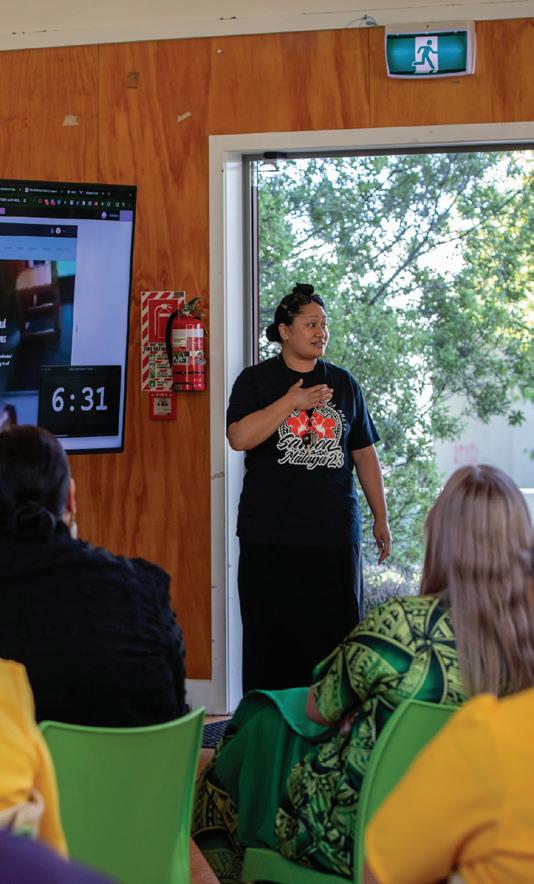
Pacific Enterprise People Ltd (PEP) is run by husband-and-wife duo Salā Marie Young and Suitauloa Simon Young.
PEP partners with funding providers to support grassroots community organisations in the fields of governance and technology, empowering organisations to achieve the dreams on which they were founded.
Before PEP, Salā and Suitauloa aided multinational corporations in Asia with technology to bridge cultures. They led workshops and spoke at conferences across the Asia Pacific. Now, they focus on governance and technology needs in Pacific communities.
Salā Marie hails from the Samoan villages of Sapapali’i, Saleimoa and Leauva’a. As a Palagi (Pākehā) Suitauloa Simon chose to take a title from Leauva’a to serve and understand the Samoan culture.
Ministry of Education licensing criteria
The Digital Marketing Pilot has been an important way for the centres to recite, demonstrate and include the Ministry of Education’s licensing criteria GMA 1–5.
GMA 1: Displaying information
GMA 2: Access to parent information
GMA 3: Information provided to parents
GMA 4: Parent information
GMA 5: Philosophy statement
Many of the early learning services involved in the pilot say important policies and information have always been on display. However, with parents being busy and swiftly picking up and dropping off their children, they often didn’t read that information.
With the website being a digital extension of their bricks-and-mortar premises, it makes it easier to access information like policies and reports, and simplifies the process of booking site visits, making enquiries, and enrolling.
11 Tukutuku Kōrero 8 April 2024
The team from Akoteu Falemaama –West Auckland’s only Tongan Christian early learning centre.
Alofa presenting the Aiga Salevalasi Aoga Amata website to the Ministry of Education, and fellow early learning services who took part in the pilot.
FEATURE: BLENDED LEARNING
Exploring successful blended learning practices
Blended learning is changing the face of modern education, offering a seamless integration of in-person, online and remote learning experiences tailored to individual student needs.
Schools across Tāmaki Makaurau are embracing this approach, implementing robust and accessible learning architecture, creating a culture of student agency, and supporting the wellbeing of kaiako, ākonga and their whānau.
Last year, The Pam Fergusson Charitable Trust explored blended learning practices at several Tāmaki Makaurau schools.
Wesley Primary School Te Kura Tuatahi o Wēteri (Wēteri), Tāmaki College, Greenhithe School, and Te Aho o te Kura Pounamu (Te Kura) are among those leading the way.
At its heart, blended (also known as hybrid) learning offers a way of designing for learning that isn’t determined
by location in the first instance. The intention is to enable learners to have choice about where and how they participate, and to be able to seamlessly transition between in-person and remote locations as their circumstances or need requires.
As Tāmaki College, vice principal Russel Dunn says, “We want learning to happen no matter where you are, or when you are!”
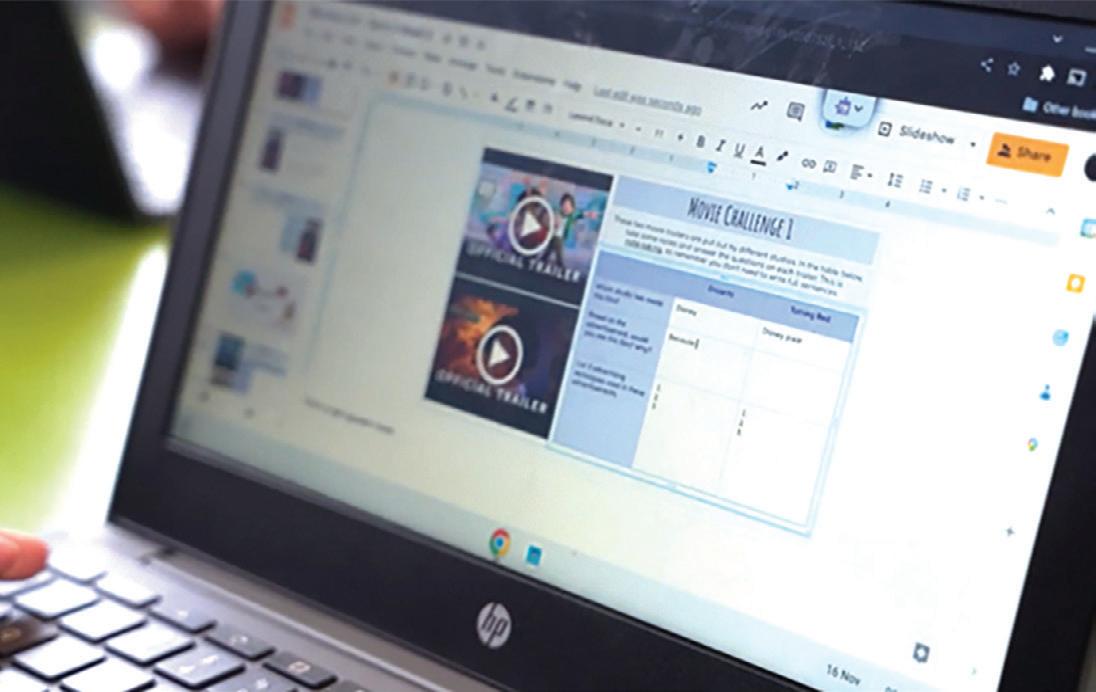
12 Education Gazette gazette.education.govt.nz
Using learning slides to choose tasks at Greenhithe.
When Sophie, 18, started at Te Kura, she only worked when her mum reminded her.
But soon, “I started finding my own way of doing things, having it open and ready, making sure I was doing it not in my bedroom, having an idea of what I was going to do before I started.”
Her classmate Dylan also had to adjust – he was burning out from trying to do every available option.
“I was going as fast as I could,” he laughs. “But now I can pace myself, go slowly, and pick what I want to learn.”
In Years 5 and 6 at Greenhithe, ākonga choose daily can-do and must-do activities from that week’s set of learning slides.
Year 5 kaiako Adele Chichester says, “All of their learning for the week is in one place for them to access at any point. This means if they are away from school for whatever reason, the learning that’s happening in the class is still accessible.”
Ākonga complete tasks directly in the editable slideshows or follow links to external sites. Since learning slides were introduced, Year 6 kaiako Emma Pierce notes that students seem a lot more confident in themselves.
“[It’s] because they can see that we as teachers have confidence in them, and we trust them to manage themselves. I think that giving them that confidence has made them feel like they can do more, and they push themselves further.”
Tamaki College deputy principal Russel Dunn describes how with a hybrid setup, they can be highly individualised.
“Those who need to go slower can get more support. And at the end of the day everyone’s needs are being met.”
Raising engagement
Wēteri centres its programme around the pedagogy of ‘learn, create, share’.
Ākonga blog to share their learning with whānau and community. They take pride in their blogs and often maintain them over the summer. Seeing this, the school began running optional summer learning opportunities onsite.
Principal Lou Reddy recalls, “Forty-five kids in the school holidays coming in daily to do maths – who would have thought?”
But to the tamariki, it’s not just maths, as Lou explains. “What they’re doing is problem solving with their mates. And it’s gamified, because every time they pitch [a solution] to each other, they get a buzz out of it, they get feedback from each other. They get the questions to go deeper from each other.”
Lou sees this kind of collaborative learning, where multiple perspectives are valued and multiple solutions are possible, as a positive move.
Involving whānau and the wider community in learning is key for Lou. He describes co-designing graduate profiles with whānau and inviting whānau into school for talanoa.
Lou describes ākonga as, “looking out for an island that isn’t on the horizon yet, but you know it’s there, and you know how you’re going to get there.”
“They can see that we as teachers have confidence in them, and we trust them to manage themselves. I think that giving them that confidence has made them feel like they can do more, and they push themselves further.”
Emma Pierce


13 Tukutuku Kōrero 8 April 2024
Wēteri tumuaki Lou Reddy describes how a strong blended approach empowers ākonga.
Te Kura student Dylan says their termly Wellbeing Survey pushes him to self-reflect.
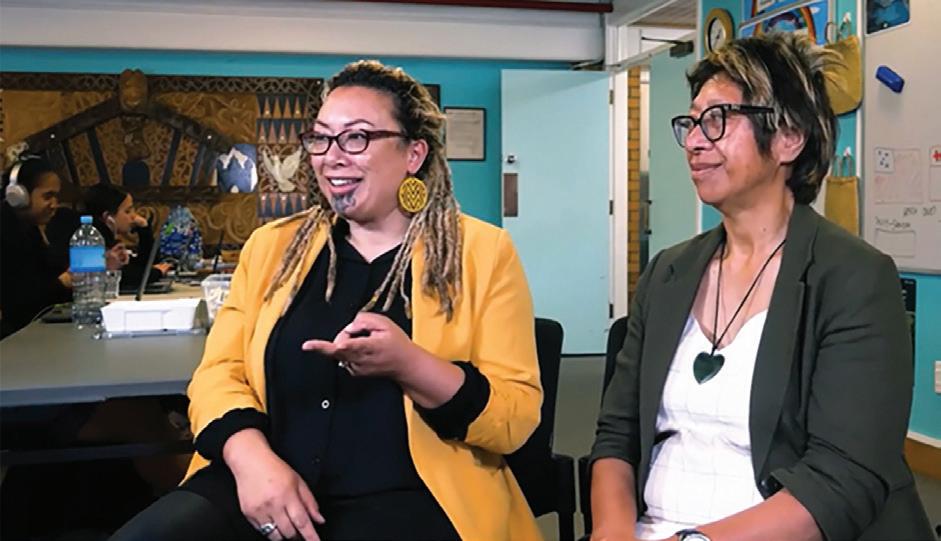
“We plan the in-class learning, the workshop learning, and the learning slides. We’re doing one area comprehensively, making sure the students have access to everything they might need.”
Charlotte Pollard-Brown
He describes the school as the vessel for ākonga along that journey, and explains how their whānau, their culture and their beliefs are behind them too – providing the wind in the sails.
“We are just one foundational piece. They have whānau, early learning, us – we are the third group of significant adults that has anything to do with those children. We have to understand them and know where they have been already, to give them the best that they deserve.”
A central space
Storing all ākonga activities and resources in one central, user-friendly online place is common practice as part of a successful blended learning approach.
At both Wēteri and Greenhithe, ākonga access learning via a weekly Google Slides presentation containing differentiated learning choices and links to external sites and resources.
“It’s essentially just putting activities that you would do in the classroom into a slideshow, so the students can do them independently on their devices,” says Greenhithe kaiako Charlotte Pollard-Brown.
“I make sure all the bases are covered and they’ve got differentiated learning that they can do independently, which has been really big for them.”
Max, in Year 6 at Greenhithe, says, “I like the way
learning slides are set up because they’re really easy to access and then you can just scroll down, decide what you want to do and then get on with your work.”
Tāmaki College is a founding member of the Manaiakalani Kāhui Ako. Russel describes how the kāhui ako is “a group of like-minded individuals who wanted to provide communities with skills for a digital world”.
The kāhui ako goal is to raise student outcomes through digital technologies, media, and thoughtful teaching practice, and so they designed a learner management app called Hāpara (meaning dawn), now used in over 40 countries.
Hāpara brings together information from multiple online platforms, shows ākonga a dashboard with assignments from across their subjects, and includes notifications for feedback alerts and due-date reminders. The kaiako dashboard shows each student’s mahi across various apps.
Collaborative planning
Storing learning materials on central online platforms supports teachers to contribute resources to a shared pool. Charlotte says it takes a lot of the pressure off.
“Planning collaboratively has been massive for my wellbeing. It means I don’t have to spend hours and hours planning each curriculum area. We take one each and plan that for two weeks.
14 Education Gazette gazette.education.govt.nz
Te Kura kaiāwhina Leilani Kake and Rita Beckmannflay.
“We plan the in-class learning, the workshop learning, and the learning slides. We’re doing one area comprehensively, making sure the students have access to everything they might need.”
Andy Crowe, assistant principal at Wēteri, says collaborative planning has “changed how the clock works. Staff come in later and leave earlier, we have more time with our own families”.
Storing content online also makes relief teaching easier. Charlotte says, “That has been massive. When I’m away, I know the students are getting quality learning.”
Russel also describes how new kaiako who start midyear can seamlessly take over since all course content, planning, and in-progress ākonga mahi is online.
Before the school’s resources were cloud-based, “if a teacher left, you lost all the content and knowledge that they had developed. Now when the new teacher rocks up, they just pick up from where you left off”.
At Wēteri, onsite teaching is shared too. Kaiako Sam Bound describes a workshop wall which is a collaborative planning tool between teachers and students.
“We have the focuses up on the workshop wall and the teachers that will be leading them, and the students put their photo up to choose which workshop they’d like to be in.
“It’s been really empowering for them, really manaenhancing, to have that choice over their learning and which teacher they’re with.”
Digital skills
Self-directed learning isn’t just about motivation and pace. Ākonga also need digital technology skills, says Te Kura kaiāwhina Leilani Kake.
“It’s funny,” she says. “We older ones think, they’ve got Google, they’ve got iPhones, they’re already clued up in terms of IT stuff. But that’s not true. Even general knowledge – what’s a PDF, what’s a .jpeg, how do you upload something to your Dropbox, how to see your downloads.”
Her colleague Rita Beckmannflay says supporting new ākonga to build these skills is crucial.
“Those sorts of things at the beginning are key. If it’s a disconnect at the beginning, it will be a disconnect all the way through.”
Greenhithe School makes a point of building this digital fluency in Years 3 and 4, so their self-directing Years 5 and 6 ākonga are confident online. Their system is still user-friendly enough, though, for new ākonga to jump right in.
Through the Hāpara tool at Tāmaki College, Russel says they are having more meaningful discussions with parents.
“We are enabling the parents. Now they can access their children’s learning themselves. They can ask, ‘how was that algebra lesson?’ instead of ‘what did you learn today?’ There’s a more powerful conversation in that.”
To train whānau and make sure they are cybersmart, they come into the school and have young people work alongside them. Ākonga are empowered to teach adults about email, device security and more.
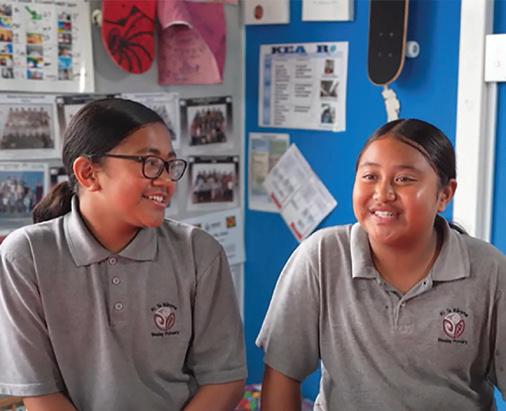
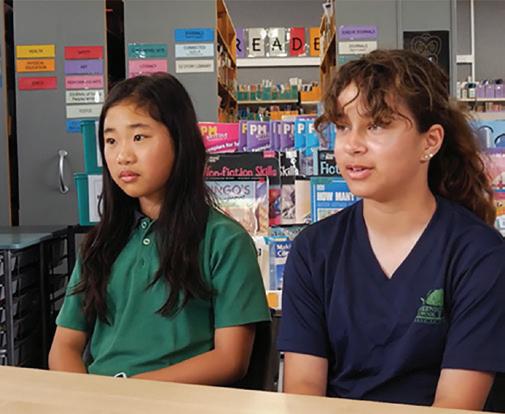
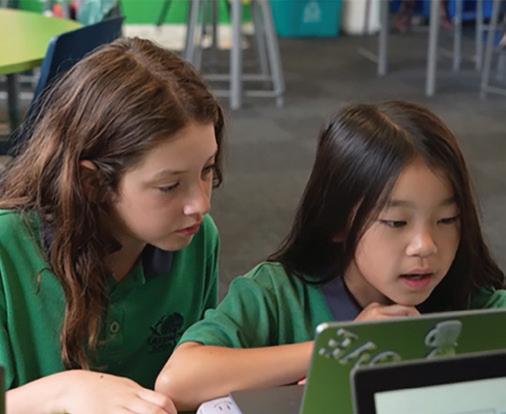
15 Tukutuku Kōrero 8 April 2024
Ākonga at Wēteri get excited about “cool opportunities to do challenges or go outside of school on trips.”
Bridget and Ellie enjoy Year 5 because “we work more independently” and “you rely less on your teachers.”
GreenhitheYear 5 ākonga are confident in themselves.
Equitable access is a priority. With support from Fusion Network and government funding, Tāmaki College provides free internet for the surrounding neighbourhood.
Similarly, Te Kura provides ākonga in financial need with refurbished devices and subsidised home internet access.
Supporting families
Wēteri and Tāmaki College act as community hubs, providing on-site and outreach services that “anyone in the community can access”, as Andy explains.
Taking a blended learning approach enables this as streamlined planning gives kaiako more time for pastoral support and community initiatives.
Some on-site services at Wēteri include the Kai Hub food bank and the Mana Clinic, a free multilingual clinic for local whānau.
Through a partnership with the Pacific Foundation, Wēteri hosts Home Interaction for Parents and Youngsters (HIPPY), providing home-based tutoring for tamariki aged 3–5 and supporting whānau with the transition into school.
“Our deputy principal Shelley Saunders runs a Talanoa group,” says Andy. “She’s involved parents from Tongan, Sāmoan and Māori whānau to give input.”
“Whānau should be participants,” he says, “not just observers, so we try to include and involve them as much as we can.”
Easy access to Hāpara from home has supported class-structure changes at Tāmaki, starting with a trial where Years 10–13 ākonga spent Mondays learning from home.
“We’ve had positive and honest feedback from the young people,” says Russel.
“Some missed the structure of the school day. Some appreciated the flexibility. We’ve since brought our Year 10s back in, but the seniors continue to work from home on Mondays. Some of them come in to do mentoring with young people.
“Those who work part-time can pick up extra shifts on Mondays. It’s going to prepare them well for study when they are beyond school. This will give them the skills to work in that environment.”
This setup is enabling ākonga to stay in school longer than they used to, with Russel pointing to how much they value family.
“It’s tough … they have to support their family in times of crisis, but they also have this burning desire to be better than before.
“If they can log on anytime instead of being stuck within school hours, that’s how we can help them stay on the journey because at the end of the day we want them to get into higher-paying employment.”
Empowering ākonga voice
Wellbeing check-ins and personal reflections are key to a successful blended learning approach.
Built into the Te Kura website, these check-ins support all ākonga to be heard by their kaiako. For those who are socially anxious or just more comfortable posting a comment than talking face-to face, this is a game-changer.
Te Kura student Dylan says their termly Wellbeing Survey pushes him to self-reflect.
“I’m not very good with emotions … filling it out
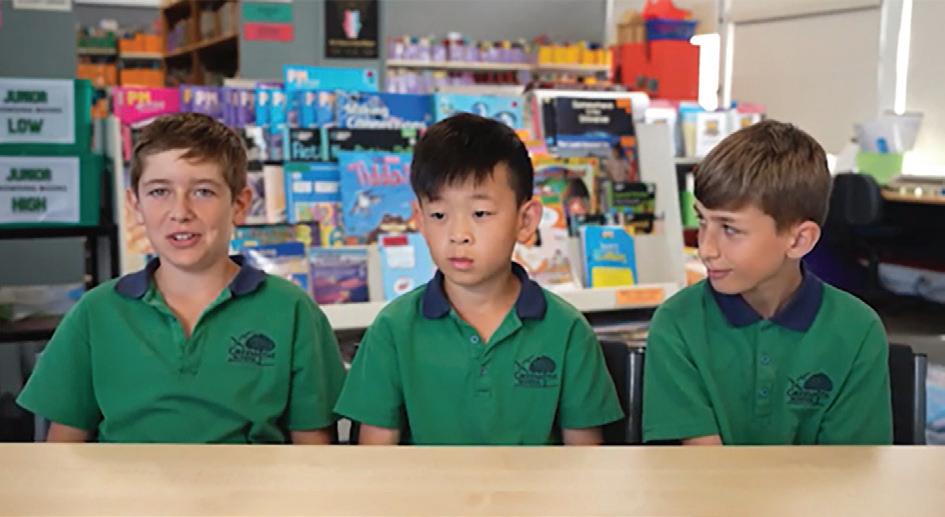
16 Education Gazette gazette.education.govt.nz
Greenhithe ākonga Reuben, Yanxi and Max confidently self-direct with their learning slides.
was, I wouldn’t say emotional, but a little eye-opening to who I really was.”
Their most vulnerable ākonga work with kaiāwhina, non-teaching staff whose focus is pastoral support, “but it’s so much more than that”, says kaiāwhina Leilani.
“My personal focus is on trying to grow them as young people in society, become critical thinkers, become responsible … and so we talk about things like gender, racism, all things under the sun. Because if we’re not having a talanoa, a kōrero… where else are they going to find it?”
“Their wellbeing affects everything – their wairua, their tinana, and whānau. Most of all it affects their connection to their turangawaewae.”
Catherine Anthony, who has been managing kaiāwhina since the role was introduced in 2020, says, “we deliberately hired kaiāwhina who had experience at working in a culturally responsive way, with empathy, good people skills and the ability to build relationships and meet students and families where they were at.”
These are just some findings from the Pam Fergusson Charitable Trust project on future-focused education, conducted with support from the Ministry of Education. It includes case studies in English and te reo Māori, a self-led course for school leaders, and a series of podcasts for whānau.
omgtech.co.nz/future-of-learning.
“[Parents] can access their children’s learning themselves. They can ask, ‘how was that algebra lesson?’ instead of ‘what did you learn today?’ There’s a more powerful conversation in that.”
Russel Dunn
Hyrbid Learning Guides
The Ministry of Education has several guides to support blended/hybrid learning practice, including te ao Māori and tikanga Māori, online safety and security, maintaining special character, accessibility and inclusion, leadership support, and more.
Visit learningfromhome.govt.nz to find out more.
Read this article online for bonus content, including further reading about how these schools integrate practical learning opportunities as part of their blended approach.

17 Tukutuku Kōrero 8 April 2024
Senior Te Kura ākonga Sophie, Sam and Miriam appreciate the option to do hands-on courses and work experience placements.
Responsive teaching and learning crucial in new NCEA Level 1
After extensive piloting from 2021 to 2023, new NCEA Level 1 subjects and wāhanga ako are being fully implemented this year.

Many teenagers might not describe science as ‘cool’. But with the implementation of the new NCEA Level 1 subjects and wāhanga ako this year, teachers now have the flexibility to design their courses and make what could be seen as a content-heavy subject, more stimulating and relatable.
“The big difference is the shift towards local contexts,” says Andrew Mackenzie, assistant head of science at Aotea College.
During a recent lesson with his NCEA Level 1 Science class, Andrew taught his students about temperature, heat and heat transfer by explaining how umu and hāngī work.
For a lesson on sea level rise, his class had interesting discussions about Kiribati and other Pacific Island-nations that are facing an existential threat due to climate change.
Although it’s not a new approach, Andrew says using everyday examples to explain scientific concepts is the new norm.
“In the past, western science dominated our thinking and views whereas now, we incorporate a lot more mātauranga Māori and other cultural examples where appropriate,” he says.
“When students are learning about sea levels rising, we do not look only at ice melting in Antarctica. We have broadened it to, ‘How will rising sea levels affect not just New Zealand but particular Pacific nations?’ We also consider its impact in specific regions like Northland and our local region of Porirua and surrounding suburbs, for example.”
Andrew says learning that reflects local contexts and responds to students’ interests has motivated his class of 15-year-olds to engage with complex scientific concepts.
It has also helped ensure Māori and Pacific students, who comprise about 55 percent of Aotea College’s nearly 1,300-strong student population, see their culture and identity reflected in their learning, he adds. For
18 Education Gazette gazette.education.govt.nz
NCEA
more information on how NCEA requirements are changing, visit ncea.education.govt.nz
Andrew Mackenzie, assistant head of science at Aotea College, says learning that reflects local contexts and responds to students’ interests has motivated his class to engage with NCEA Level 1 Science.
A head start
Aotea College has had a head start in using the new NCEA Level 1 achievement standards, having taken part in the pilots in 2022 and 2023.
“Taking part in the mini-pilots was quite challenging but it is now paying off,” says principal Kate Gainsford.
“The level of professional knowledge that our teachers have and the quality of course design and resource development that has taken place means we are in a good position to implement the new NCEA Level 1 subjects.
“We now have significant depth of curriculum leadership because people have taken advantage of the opportunity to collaborate with others, refine resources, and engage in high-
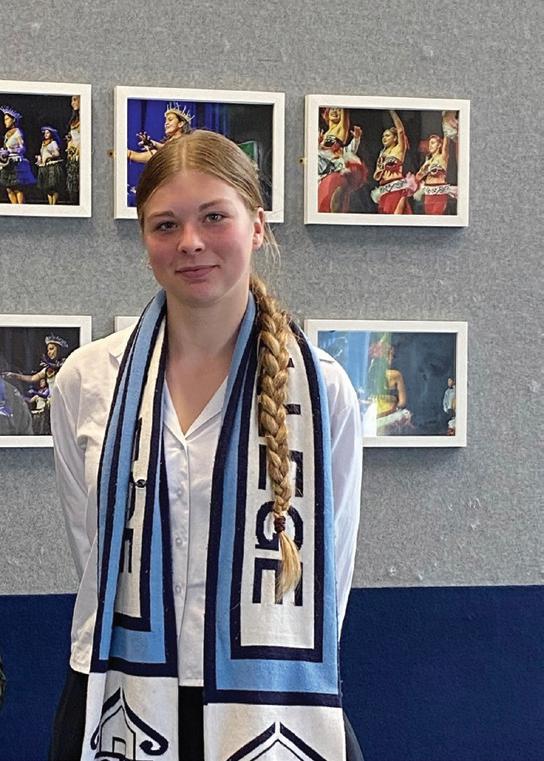



19 Tukutuku Kōrero 8 April 2024
BR A IN BUSTERS BrainBusters.co.nz Teacher resources available on our website:
Students are thrilled at having fewer assessments and loads of options to show what they know, says Annamieka.
Picking up mud crabs, counting and weighing them is not a usual part of the crab day and therefore, applying for ethics consent here is most likely needed. If you are at the estuary to look at bivalves (eg, cockles) then you most likely don’t need ethics approval but, Rachel says it's always best to ask.

20 Education Gazette gazette.education.govt.nz

The valuable role of animals in learning –ethically
Navigating the nuances and necessities of working with animals inside and outside the classroom requires careful consideration from kaiako and kura. But, when done right, it’s a practice which yields great results for teaching and learning opportunities.
The National Animal Ethics Advisory Committee (NAEAC) was established under the Animal Welfare Act 1999 to provide independent advice to the government minister responsible for animal welfare.
Under the Act, research, testing and teaching involving using live animals may require ethics approval, and this also applies to animals used in schools, on school farms, and in school activities.
The New Zealand Schools’ Animal Ethics Committee (AEC) was set up in 2005 to help early learning services, kura and schools meet their legal obligations under the Act. Most animal-related projects will require approval and proof of approval is usually required for entry into science fairs.
The committee is part of the New Zealand Association of Science Educators, and its members are people with a variety of expertise in animal welfare and teaching animal welfare. They meet several times a year to consider applications for ethics approval.
The schools’ AEC has a strong educational role, and most applicants are young school children. Where appropriate, applicants will be offered help with science and animal welfare aspects of their proposals.
Attitudes towards animals are formed early in life. For many students, early learning and school may be the first place where they gain experience on how to handle and look after animals.
Epsom Girls’ Grammar School head of biology, Rachel Heeney sits on NAEAC as its education representative, as nominated by the Ministry of Education (separate to the schools’ AEC).
Rachel says most classroom animal use in primary school involves family pets brought into school for simple observation or for learning the responsibilities of humane care. Understanding animals and biodiversity also teaches ākonga about kaitiakitanga, science, whakapapa, and the role of animal ethics in relevant industries.
“This paves the way for pathways in related fields or simply the appreciation of the world around us,” says lifelong animal lover Rachel.
Some of the more commonly featured furry – and not so furry – animals in early, primary and secondary education settings, according to the schools’ AEC, are axolotls, birds, cats, chickens, cows, dogs, eels, fish, frogs, goats, guinea pigs, horses, mice, mud crabs, rabbits, rats and sheep.
21 Tukutuku Kōrero 8 April 2024
ANIMAL ETHICS
Bird watching activities may not require ethics approval, but Rachel says it's key to have a good think about whether their behaviour is changed by the group being there.

The approval process
Teachers and students apply to the schools’ AEC for ethics approval for investigations involving animals that they might be planning.
Under the Act, ‘animal’ means any live member of the animal kingdom that is a mammal, bird, reptile, amphibian, fish (bony or cartilaginous), octopus, squid, crab (including half crab), lobster or crayfish (including freshwater), and includes any marsupial pouch young or mammalian foetus, or any avian or reptilian pre-hatched young, that is in the last half of its period of gestation or development.
Any project or teaching that might affect an animal’s normal physiology, behaviour, anatomy or practices outside their usual care, requires ethics approval.
If teachers apply for project approval for an investigation that is going to be repeated, they can apply for a three-year approval. In these cases, there should be at least two teachers from the school on the application, in case one teacher leaves the school over the assigned approval period.
It is important to apply one term ahead of the animal-
related activity, as retrospective approval cannot be given.
Rachel says what is important for students and teachers to consider is, “Do I need ethical consent to carry out the work?”
“If in doubt, contact the chair of the schools’ animal ethics committee and ask them a question. They are very happy to help.”
Sharing learnings
Rachel says she realised, as a teacher, if she was confused about the dos and don’ts of working with animals in an education setting, other teachers would be too.
“Some teachers don’t realise that they need to apply for approval, when, and for what. In the past, people have thought that if it’s not an activity in a science lab, it doesn’t need approval.
“None of the procedures are set up to make a teacher’s life harder – but we are governed under the Act and with guidance from your AEC the process will be transparent and straightforward. We can then pass on this focus of considering the welfare of all animals to our learners.”
22 Education Gazette gazette.education.govt.nz
Teaching at Epsom Girls’ for 26 years, Rachel has encountered many scenarios and is keen to share her learnings with others. In September, she will be speaking at the Australian & New Zealand Council for the Care of Animals in Research and Teaching conference in Christchurch about the use of animals in the teaching space.
Some teachers worry about what they need to gain approval for and what they don’t, says Rachel.
“I want more people to have the confidence to ask questions when it comes to animal use.”
Rachel says looking through a te ao Māori lens is also an important thing to do.
NAEAC has a subcommittee in place to consider how matauranga Māori can be incorporated into their work. One of their projects has been to make sure, through revised guidance material, that organisations indicate how they have considered the principles, values, and practices from te ao Māori in their work when submitting a code of ethical conduct to the Ministry for Primary Industries.
When working with animals in a science fair project, teachers are also encouraged to consider seeking advice from local Kaumātua or the school’s kaitiaki where appropriate.
Fostering empathy and kindness
Growing up in Kawakawa, Northland, Rachel was exposed to a range of animals from a young age.
“I have always had animals around me,” she says. “And I have always been taught to treat animals respectfully. I want to help educate teachers and students on the ethical ways to involve animals in their learning. If people know how to do the right thing, they usually will do it. And using animals in teaching programmes can really help engage ākonga in their learning.”
Applying for animal ethics approval can be a valuable educational experience and learning opportunity for young students, says Rachel, teaching them about responsible research and ethical considerations.
“Young students develop a sense of responsibility and compassion for animals by understanding the importance of their welfare. The process of animal ethics consideration instils the value of respecting all forms of life.”
Rachel says ethical research practices encourage students to apply scientific methods properly, which is a valuable skill for academic development.
“Encouraging students to apply for animal ethics approval can be a valuable step in nurturing their curiosity and guiding them toward becoming responsible, ethical, and compassionate individuals.
“Understanding the importance of following the law also introduces students to legal and regulatory requirements for working with animals,” explains Rachel.
“It’s important for students to see that scientists, like us, can’t just do anything they want to. We are all required to go through these procedures.”
A case of cats in class
Rachel shares a story of an intermediate teacher who needed to apply for ethics approval for a student’s project that would see them monitoring cats’ play behaviour. The student wished to compare whether cats trialled had a preferential left or right paw. She would test four different pet cats, recording video then tally the play behaviour in a set time of five minutes per cat.
“From the outset, I could see this was an interesting project of the calibre that could enter the regional science fair.”
In this case, it is important to begin the process of engaging with the school’s AEC right away.
“A good thing about this process is that doing external science fair projects ensures teachers evaluate ethics for new experiments – including the projects they may not enter for competitions. It also educates students that there is a process to control the use of animals.”
A schools’ AEC flow chart allowed students to make a choice and decide whether to proceed with their project ideas.
“This led to many re-evaluating their projects to ensure they had considered meaningful use and testing with animals or choosing alternatives not requiring ethics approval.
“Ethics are important. Ethics need to be questioned and their value in the scientific process is essential, and this should start when students are ready to make informed decisions about the care and use of animals.”
Find the flowchart at animalethics.org.nz/flow_chart.
Further reading
For more information, links and resources about using animals safely and legally, and to enhance your teaching programme, visit scienceonline.tki.org.nz.
Teachers can contact animalethicscommitteenz@gmail.com if they are unsure of the requirements, prior to allowing students to start their projects.
The schools’ AEC application forms can be filled in online. This makes sharing information much quicker and easier for all concerned. Applications need to be received at least two weeks before the AEC meeting.
Visit the Animal Ethics website to apply for approval at animalethics.org.nz.
23 Tukutuku Kōrero 8 April 2024

CURRICULUM RESOURCES
Tāhūrangi – a ‘one stop shop’ for curriculum content
The Ministry of Education’s online curriculum hub, Tāhūrangi, has been live since November last year and is now home to more than 4,000 teaching resources.
Tāhūrangi has been designed to be a ‘one stop shop’ for teachers and kaiako, removing the need to hunt through multiple websites to find quality curriculum content for Te Whāriki: He Whāriki mātauranga mō ngā mokopuna o Aotearoa Early Childhood Curriculum, Te Marautanga o Aotearoa, and The New Zealand Curriculum.
“We’re hugely excited to be able to offer this technology solution to our educators,” says Pauline Cleaver, general manager strategy & integration of the Ministry’s Te Poutāhū | Curriculum Centre.
“It offers so many benefits and will make life much easier for our hardworking, busy teachers.
Not only is it more efficient to house all content in one place, but Pauline also says teachers can have confidence that everything on Tāhūrangi is relevant, up-to-date, and in line with the current curriculum.
“As part of our commitment to being a curriculum centre of excellence, we are delighted to be able to deliver a solution that will become the first port of call for teaching guidance, curriculum and assessment news, and quality resources.”
Key features and benefits
Tara Taylor-Jorgensen, director of integrated delivery, explains that Tāhūrangi was designed to be fulsome, easy-to-use, and customisable.
“We spoke to teachers as we were developing the site, to find out what their biggest frustrations were when it came to finding curriculum resources.
“We heard how time-consuming it was for teachers to find material, and that many were using old, downloaded documents for years and years –such that it became hard to check if the resources had been updated or refreshed.”
As the site was developed, Tara says they made sure it included sophisticated search and organisational features, making it quick and easy for users to reliably find and organise teaching resources.
“We’ve also made it so teachers can create and share ‘collections’ of resources – which is really efficient and a great time-saver for everyone.
“When we demonstrated Tāhūrangi’s features to our user test group, it’s fair to say they were relieved and excited about what it can do.”
24 Education Gazette gazette.education.govt.nz
Visit tahurangi.education.govt.nz to access Te Whāriki Online, Te Marautanga o Aotearoa, and New Zealand Curriculum Online.
Where is content coming from?
Content from more than 70 education websites is now being moved on to Tāhūrangi. Every item undergoes a quality check before being uploaded, to ensure it is fit-for-purpose, relevant, and meets, as far as possible, accessibility criteria.
“It’s a big job, so we’re staggering it over the next few months,” says Tara. “More and more content is being added every week and, as we finish each move, the website that originally housed the material will no longer be available.
“Many of these older sites are not frequently used, so there shouldn’t be too much disruption, but for those that are, for example nzmaths.co.nz and arts online, we’re providing lots of advance warning and support to help users prepare for the change.”
Tara adds that their best advice to teachers is to visit Tāhūrangi and familiarise themselves with the site.
“It will look different to what you’re used to, but it’s like any new student on their first day of school … it takes a couple of visits to find your way around, but before too long its second nature and you know where everything is.”
Early learning content
All content related to Te Whāriki: He whāriki mātauranga mō nga mokopuna o Aotearoa Early Childhood Curriculum is now available on Tāhūrangi.
This means that this part of Te Whāriki Online will soon be retired and will no longer be accessible. Te Whāriki a Te Kōhanga Reo will be available via a link on the Tāhūrangi homepage to Te Whāriki Online.
NZMaths website
Relevant, up-to-date teaching resources from nzmaths. co.nz are now being moved to Tāhūrangi. This includes the majority of Pāngarau resources that support Te Marautanga o Aotearoa.
Access to e-ako maths and e-ako Pāngarau will continue to be available through current logins. The move was scheduled to take place during February/March however, following user feedback, the timeframe was extended so users have more time to prepare for the change. The nzmaths content move is now expected to be completed by 30 June 2024.
Questions or feedback
If you have questions or want to provide feedback about accessing particular resources, please email curriculum. publishing@education.govt.nz.
A warming winter menu to nourish your tamariki
Heart Foundation’s solution for wholesome and affordable menus
Providing wholesome, affordable kai for tamariki in early learning services is sometimes easier said than done.
The Heart Foundation can help take the hassle out of menu planning with our new FREE four-week winter sample menu. We provide you with inspiration for morning tea, lunch and afternoon tea, designed to sustain active and growing tamariki.
Our collection of budget-friendly recipes has been designed to provide your hungry eaters with long lasting energy and flavours they will enjoy, all while meeting the
Ministry of Health’s food and nutrition guidelines. Being seasonal, this helps to keep the cost of food down.
What’s more, our four-week cycle menu meets the highest (Pā-Harakeke) level of our Tohu Manawa Ora | Healthy Heart Award. You can use it as a starting point for any of our award levels or use it in its entirety.
Feel confident in knowing you’re providing nutritious and safe food to tamariki, fostering their confidence as well-rounded food explorers!
For your FREE copy of our sample menu or to sign up to our Tohu Manawa Ora | Healthy Heart Award, please get in touch with us!
Visit heartfoundation.org.nz/educators or email education@heartfoundation.org.nz




ADVERTORIAL
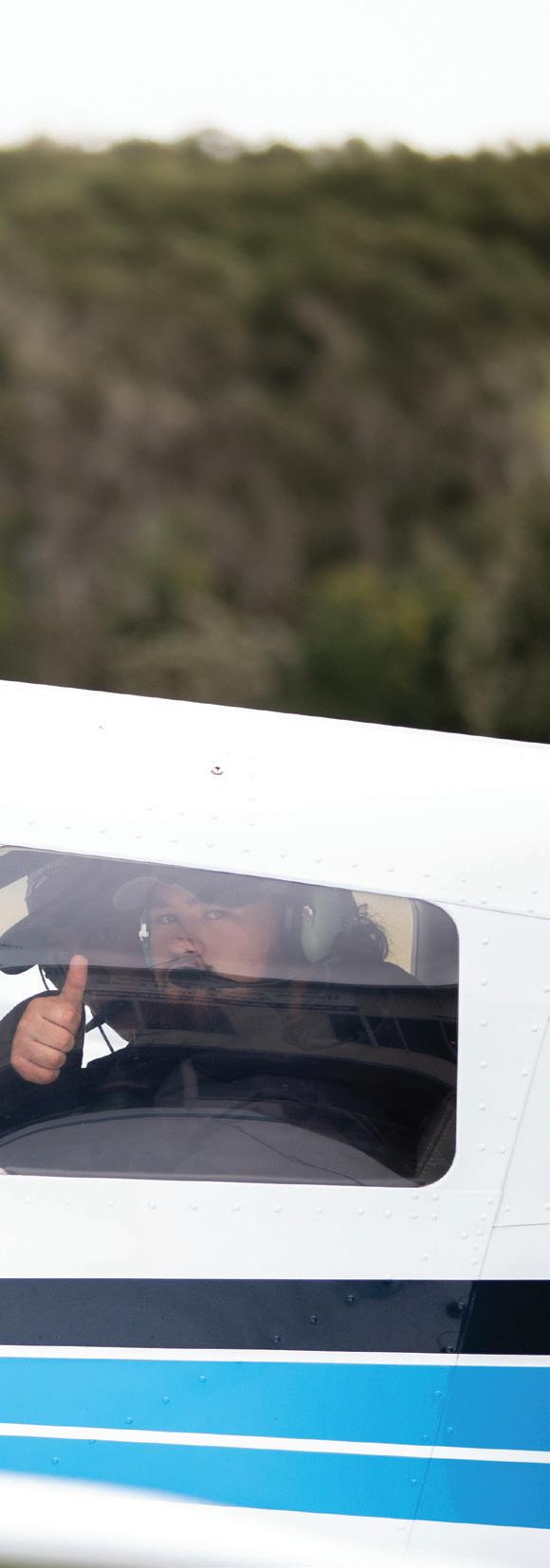
For many young people, obtaining a driver’s licence is often seen as a gateway to freedom and independence. However, it goes beyond simply being able to drive a car. Licences are essential for many professions, enabling individuals to pursue the careers they are passionate about.
The “Got Drive” Careers Roadie provided ākonga with valuable insights into potential career pathways through a series of engaging activities and workplace visits, while also giving them the opportunity to learn about the different licences each role requires.
The day was also organised in support of the Got Drive Trust and the work that they do, including providing the school with a vehicle for driver training for two weeks.
Nine Tamatea High School ākonga arrived at school during their holidays unsure of what they were in for, except that it was “a careers thing day”.
With lots of planning behind the scenes and special permission from their parents, this eye-opening event was something they will not soon forget.
The Careers Roadie was the idea of senior constable Jason Bryant and Tamatea High School’s community police officer, senior constable Mark Johnson, who showed up ready to transport ākonga. A contact through the police officers had provided two Ferraris for the students to be driven in.
With Tamatea High head of careers Cindy Morgan having planned everything to perfection, the day was ready to begin.
A roadie like no other
The first stop of the trip was to the Art Deco Trust, where ākonga learned the important part a passenger endorsement plays in the tourism industry. The trust introduced them to another of their tour cars, a vintage Cord. The Cord joined them on their travels, with ākonga taking turns to enjoy each vehicle along their way.
Another stop was the Napier Fire Station. Here, ākonga learned about the licences required for driving emergency vehicles and gained an understanding of the vital role licensing plays in ensuring public safety. They had an opportunity to explore the fire trucks, wear the safety gear, feel the power behind a running fire hose, and watch a fire drill.
Next, ākonga visited Beckett Earthmovers, where they learned about ‘Wheels, Tracks and Rollers’. Cindy says ākonga observed a large GPS-using-digger and had a chance to talk to its 24-year-old operator and admire his employer-provided ute.
After learning the importance of specialised licences in the construction industry and speaking to operators, ākonga gained valuable insights into the skills and qualifications required for such roles.
The final stop of the day was Hastings Aerodrome to hear about what is involved in gaining a pilot’s licence. Flight instructor Dominik Box-Wilson shared his passion for flying, starting as a teenager in the club’s Young Eagles programme and working at a supermarket to pay for his flying lessons.
27 Tukutuku Kōrero 8 April 2024
He showed students around the planes, took them to try the flight simulator and then in threes, Dom took them up in the air. With stunning views of Te Matau-aMāui, ākonga travelled across the Heretaunga Plains, around Te Mata Peak and back.
Those in the front seats of these trips were offered the chance to fly the plane, the lucky student decided by a high-stakes game of Rock, Paper, Scissors.
“For many, it was their first ever flight, so it was a highlight,” says Cindy.
With spirits as high as the planes they’d just been in, it was time to head back to school.
“It was a wonderful, memorable day for all concerned. The hosts got a buzz from the students’ enthusiasm, some students danced on their way to the plane!” explains Cindy.
“The accompanying adults enjoyed the students’ excitement as they found out about each stop. The students learned not only from each experience but also the adults accompanying them.”
Journey to success
Beyond the excitement of flying planes lies a valuable lesson for students – licences open doors to a wide range of career opportunities they might never have thought possible.
Whether it’s driving emergency vehicles, operating heavy machinery, or piloting planes, licences are essential.
For ākonga contemplating their future career paths, obtaining the relevant licences early on can give them a head start. It not only demonstrates their commitment but also equips them with the necessary skills and qualifications to succeed in their chosen field.
Cindy admits a lot of planning and organising went into making this ‘Careers Roadie’ successful.
“Yes, it was a lot of hard work, but it was a buzz for all concerned. Several students sent thanks to me that same evening.”

Some of those thanks included Zack who emailed that night to say, “I’d like to thank you for one of the best days I’ve ever had. All your hard work organising this incredible day I hope paid [off] as I can say with all honesty it was one of the best days of my life. Thank you again and we all appreciate it.”
Almahmud emailed to say, “I’m deeply grateful for today’s incredible experiences. I learned a lot about fire trucks, excavators, and even took a thrilling plane ride. Your guidance and support have been invaluable. These memories will always stay with me. Thank you from the bottom of my heart.”
The “Got Drive” Careers Roadie showed ākonga that the sky is the limit for career opportunities and sometimes, the journey to success begins with obtaining the right licences.
“I’m deeply grateful for today’s incredible experiences. I learned a lot about fire trucks, excavators, and even took a thrilling plane ride.”
Almahmud, student
28 Education Gazette gazette.education.govt.nz
Ākonga enjoyed connecting with Fire and Emergency NZ to learn about the licences needed to drive emergency vehicles and the role of licensing in public safety.
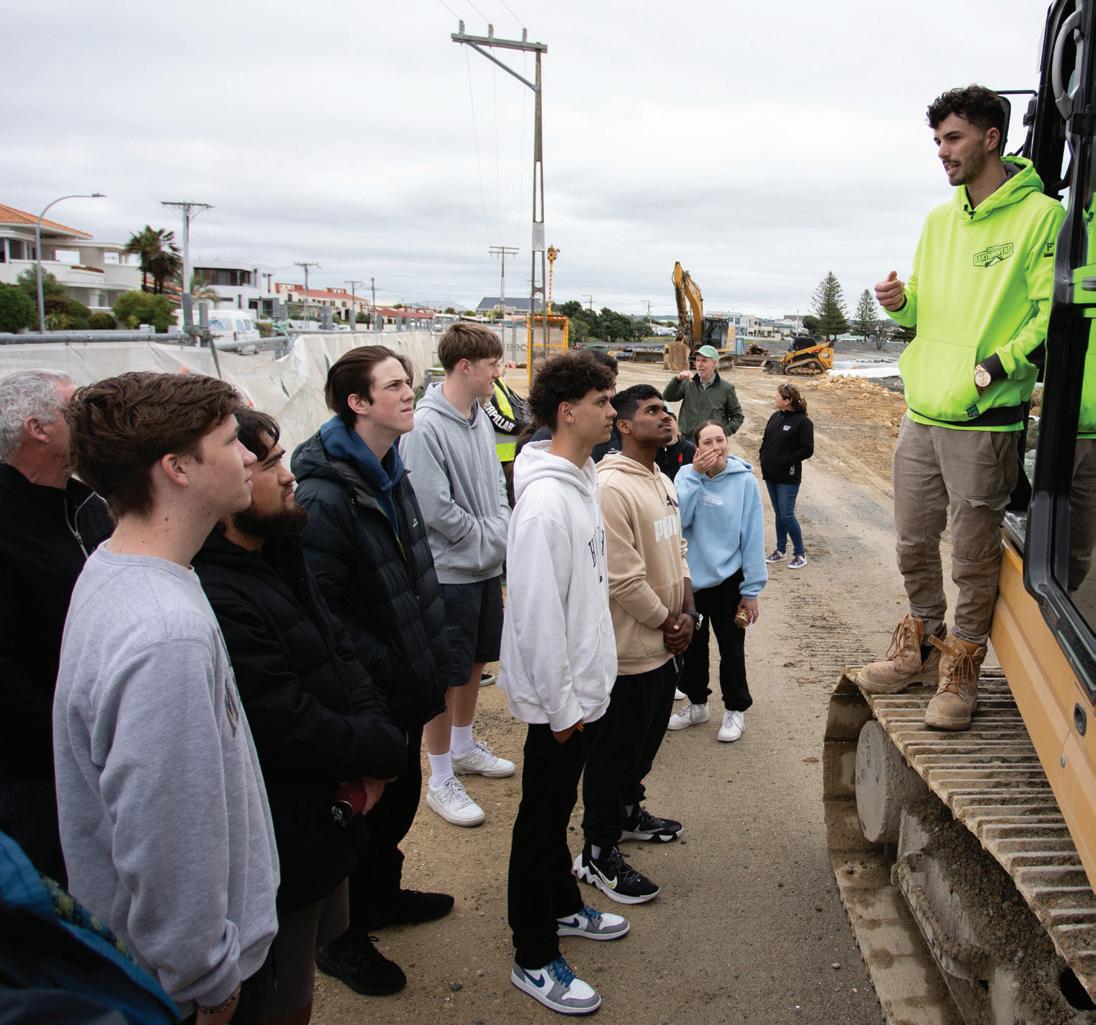
Head of careers at Tamatea High gives tips for success
» Make the attainment of a Restricted driver’s licence a priority. It gives students a real sense of achievement and provides them with photo ID.
» Take a chance on a great opportunity. The Careers Roadie came about because one day, I was called about a man with a Ferrari who wanted to use it for some good. He drove into the centre of school, took one student for a ride and the relationship has grown ever since.
» Work together for the good of the students. Our wonderful community police officer trained up to become a driving mentor. He is in my classroom and in school for two weeks a year taking students out driving. Through this, he forms strong, positive relationships with the students and is also on hand for helping those who have questions about driving and the law.
» Build and look after your networks and use your connections. Our communities want young people to succeed and do well. If you ask, it is surprising who will assist you.
» The element of surprise can enhance the experience, while their parents knew and gave permission for all activities, we kept things deliberately vague for the students.
» Give the students room to step up and rise to the occasion. All students had to publicly give thanks to someone, somewhere. They all did it well and were proud to have the opportunity.
» Plan well but be flexible and have a contingency! It rained solidly on our original day, so we had to quickly rearrange for the following day.
» Young people are a treasure. They are fun and wonderful to be with. While our students delighted in their rides in the Ferrari, the owner thoroughly enjoyed getting to know the students and finding out about their hopes and dreams.
29 Tukutuku Kōrero 8 April 2024
Sam from Beckett Earthmovers explains his career journey and the advantages of an infrastructure career.
 Heinrich, Year 13 at St Bede’s College and Nina Oberg Humphries, sponsor of this year’s Measina Creative Award.
Heinrich, Year 13 at St Bede’s College and Nina Oberg Humphries, sponsor of this year’s Measina Creative Award.
Canterbury Pacific learners off to an energetic start with SPACPAC
Now in its 14th year of running, SPACPAC, a programme organised by the Ministry of Education in partnership with local Canterbury secondary schools and the Pacific community, has returned with a jam-packed agenda sure to keep young Pacific learners equipped with the tools they need to succeed.
Education Gazette explores the programmes’ term 1 journey of helping Pacific secondary school students reach their full potential.
Pacific learners in Canterbury have had an exciting and rewarding start to the year with the support of sPACIFICally Pacific (SPACPAC).
With the aim of fostering academic excellence and holistic growth among Pacific learners, the SPACPAC programme embarks on its annual journey with two pivotal initiatives: the SPACPAC Leadership Retreat and the SPACPAC Canterbury Pacific Youth Awards.
“It’s important for the [Pacific learners’] educational journey to see tangible support from their school and local community, and to have their languages and cultures embraced by the very people that help shape their learning. At its core, this is what SPACPAC is about,” explains Viane Makalio, the Ministry of Education’s lead advisor Pacific engagement in Canterbury and co-chair of the SPACPAC Collective.
“Both initiatives serve as an opportunity to nurture the achievements of these young learners while also boosting the visibility of their achievements to their fellow Pacific learners, so that they may follow in their footsteps.”
Leading by example
The well-known saying ‘o le ala I le pule o le tautua’ (the pathway to leadership is through service) is widely embraced by Samoans as a fundamental life principle. Although Samoan, the sentiment of the adage holds true across many Pacific nations.
The SPACPAC leadership retreat centres itself on fostering these values of Pacific leadership and encouraging participants to put their best foot forward in their service as leaders.
The retreat had a full agenda for over one hundred Pacific student leaders from 25 schools across Canterbury, including special guests from the Marlborough region, as they engaged in workshops on leadership, governance, and Pacific identity/belonging.
An important part of the day was bridging their opportunities to meet with peers and community leaders from across the region.
Marlborough Girls’ College student leaders Ginaietta and Funaki shared their highlights of the day and

31 Tukutuku Kōrero 8 April 2024
PACIFIC LEARNERS
Secondary school teachers and liaisons at the SPACPAC Pacific Leadership Retreat.
“I encourage [Pacific students] to step up, whether it’s in sports or academic fields or leadership. Just step out there and give it your all. I know that if you give your all and you put your mind and heart into it, you’ll achieve it.”
Funaki, Year 13
encouragement for their fellow Pacific juniors looking to follow suit.
“What I enjoyed the most [about the leadership retreat] was talking about our dreams for the future, I’ve learned how to be a stronger and better leader for my school and community,” Ginaietta gleamed.
Funaki added, “I want to encourage you [Pacific students] to step up, whether it’s in sports or academic fields or leadership. Just step out there and give it your all. I know that if you give your all and you put your mind and heart into it, you’ll achieve it.”
Celebrating success
These initiatives not only enrich the educational experience for Pacific learners but also contribute to the diversity and inclusivity of the broader learning environment.
Through its commitment to equity and cultural responsiveness, SPACPAC continues to make strides
in championing the success of Pacific learners and promoting educational excellence for all.
The SPACPAC Canterbury Pacific Youth Awards is an opportunity for students, parents, schools, and the wider community to celebrate academic high achievers for the 2023 academic year, cultural excellence, tautua/service, Pacific leadership, and an overall supreme winner.
The award aims to look beyond a one-dimensional definition of success and prides itself on acknowledging the many avenues success can stem from.
By nature, Pacific peoples are drawn to the arts and its roots in self-expression. Whether through a visual or verbal medium, storytelling is a cornerstone for Pacific creatives. One student who has found success in this area is Heinrich, Year 13 at St Bede’s College and this year’s winner of the Measina Creative Award.
“I’m very motivated by my family and my friends, they push me to be the best person I can be. God also motivates me to be the best person I can be,” says Heinrich.

32 Education Gazette gazette.education.govt.nz
SPACPAC Award winners 2024.
“My school supports me by giving me the opportunities to further my knowledge and experience in different cultures and activities so that I can decide if I want to pursue that career. My goal is to be an actor or sportsman,” he adds.
A snapshot of the year ahead
The SPACPAC programme will continue in what is shaping up to being their biggest year yet.
At the time of writing this article, preparations for the Canterbury SPACPAC Polyfest are in full effect.
Polyfest in Canterbury has gone from strength to strength, drawing in massive crowds to fill Hagley Park – a true testament of community support.
Initiatives throughout the year will cover many interests of students including the Aneriueta (Teta) Pao-Sopoanga Pasifika Speech Competition that can also help learners gain NCEA credits and a Dragons’ Den event for business-minded Pacific learners.
A Pacific Expo hosted at Te Pae Christchurch Convention Centre will also provide a general overview of future careers and employment opportunities, offering a chance for students to meet with Pacific people in these careers and employment.
The SPACPAC organisers emphasise that these initiatives are just a stepping stone in showing what is possible for these young Pacific learners and credit schools’, learners’, and communities’ partnership and involvement in making this programme what it is today.
Congratulations to all the winners of the 2024 SPACPAC Canterbury Pacific Youth Awards:
» Lincoln Mamuta, SPACPAC Community Engagement Award
» Heinrich Muller, SPACPAC Measina Creative Award
» Luatimu Taaso, SPACPAC Mana Leadership Award
» Dormay Laufiso, SPACPAC Sports Game Changer Award
» Ryder Tuitea, SPACPAC Science Excellence Award
» Te Aratai College, SPACPAC Trailblazing Innovation Award
» Angie Vaea, SPACPAC Cultural Navigator Award
» Dereon Maka, SPACPAC Charity/Volunteer Award
» Burnside High School, SPACPAC Commitment to Wellbeing Award
» Adi Jean Velodroka Teinakore, SPACPAC English Excellence Award
» Ariana Tait, SPACPAC Maths Excellence Award
» Yash Naicker, SPACPAC Academic Excellence Award
» Hannibal Ikahihifo, SPACPAC Special Award: Pacific Champion: Teacher/Staff
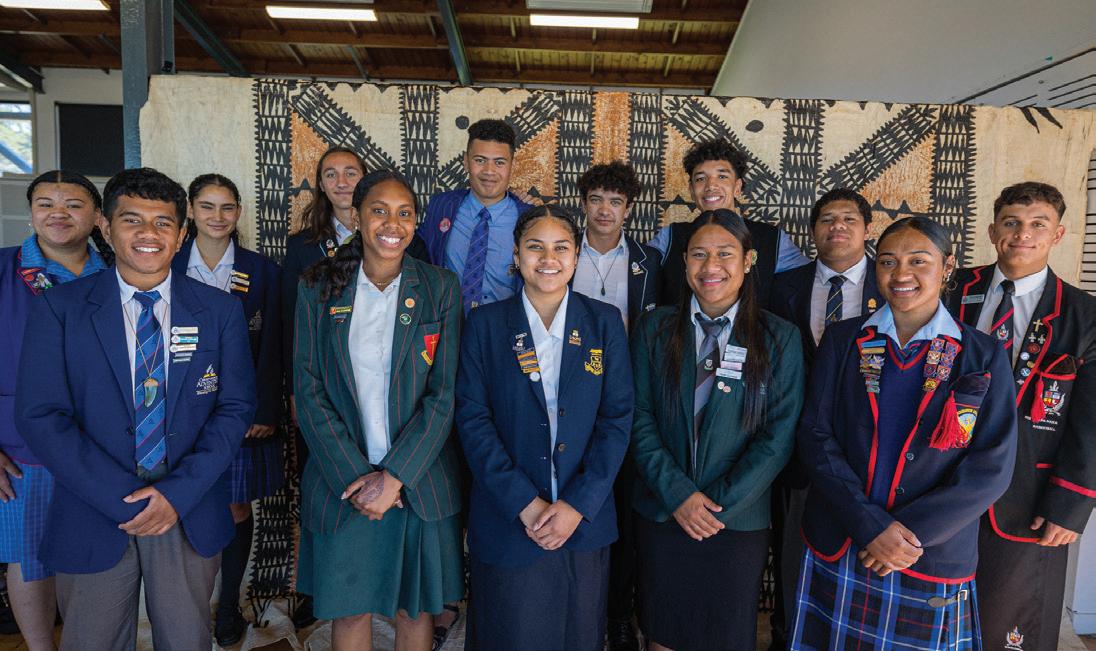
33 Tukutuku Kōrero 8 April 2024
Pacific deputy and head students in Canterbury and Marlborough.
Inspiring the next generation of women in conservation
Written by Jasmin and Paris, both Year 13 students at Sacred Heart College in Wellington, this article explores a Women in Conservation event held in March to celebrate International Women’s Day, 100 years of Forest & Bird, and the next generation of young wāhine leading the way in conservation.
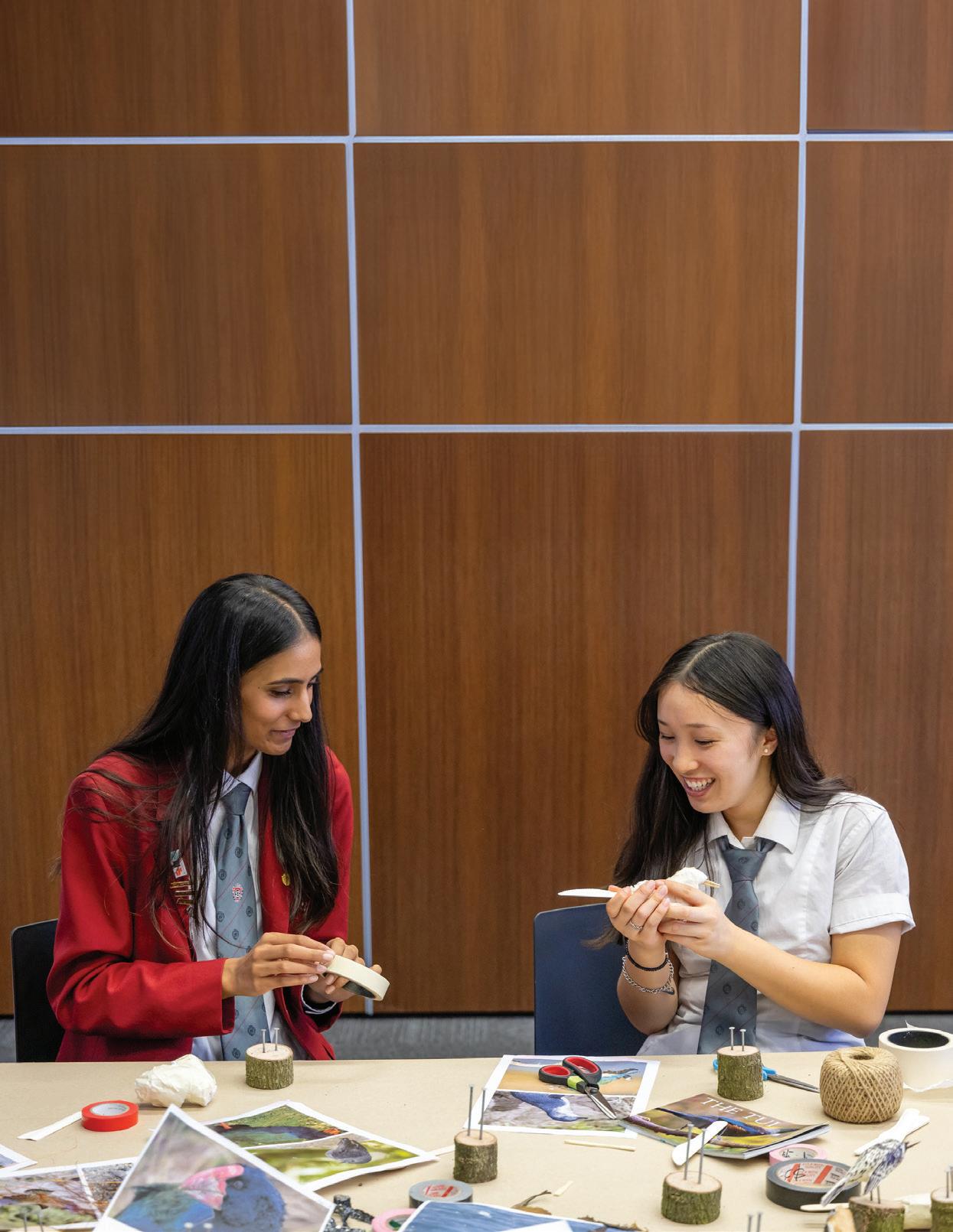
Education Gazette would love to support and publish more stories by students. Please send any ideas to gazette@education.govt.nz.
34 Education Gazette gazette.education.govt.nz
ENVIRONMENTAL
EDUCATION
Jasmin and Paris in the Arts workshop.
Image: National Library of New Zealand/Mark Beatty.
In celebration of International Women’s Day and to mark 100 years of Forest & Bird, a Women in Conservation event was held in March at the National Library of New Zealand Te Puna Mātauranga O Aotearoa, with a series of talks, panel discussions, in-person workshops and digital webinars.
The aim was to inspire the next generation of women conservation leaders to use their voices and take collective action to help the environment. We attended the event along with other secondary school and university students aged 14–24 years, teachers, and members of the public.
At the heart of the event was a panel discussion featuring leaders engaged in conservation work today. These inspiring individuals were Stephanie Rowe (deputydirector general of the Department of Conservation), Amanda Black (director of BioProtection Aotearoa), Trish Kirkland-Smith (head of nature solutions & partnerships at Fonterra), and Nicola Toki (chief executive of Forest & Bird).
They shared with attendees their experiences, insights, and strategies for overcoming challenges while advocating for environmental preservation. They highlighted the significance of authenticity (being yourself), continuous learning, acknowledging mistakes, and being open to feedback as crucial components of leadership development.
Inspirational speakers and panellists, including Lynn Freeman (convenor), Stephanie Rowe, Trish Kirkland-Smith, Nicola Toki and Amanda Black.
Image: National Library of New Zealand/Mark Beatty.
“It serves as a clear reminder for women that we must back ourselves. The panellists stressed the true path to success is through self-belief.”
Jasmin and Paris, Year 13
Watch some of the speakers on YouTube.
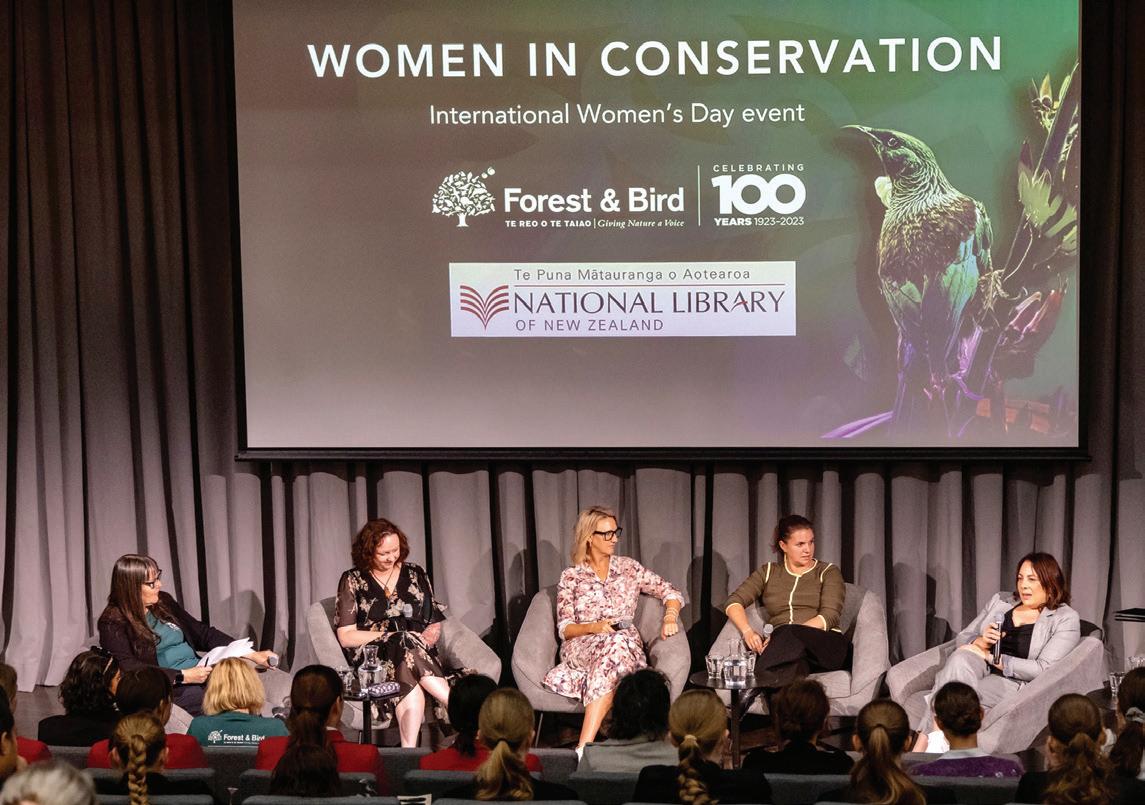
35 Tukutuku Kōrero 8 April 2024


Self-belief
When asked their greatest challenge in the workplace, selfdoubt was the most common answer. Due to our self-imposed perfectionism, women consistently hesitate to take on opportunities unless they are completely confident that they can achieve the task.
It serves as a clear reminder for women that we must back ourselves. The panellists stressed the true path to success is through self-belief.
They encouraged us to trust our own instincts and not be bothered by external opinions. One day they all hoped they would be called a “great leader”, rather than a “great woman leader”.
The insights shared by the panellists inspired us to advocate for gender equality and environmental stewardship. They serve as a reminder of the invaluable contributions of women in conservation and the ongoing need for inclusive leadership in safeguarding our planet for future generations.
Renewed purpose
The day also included the chance for students to attend an inperson workshop led by experts in their respective environmental fields: Science (Dr Kareen Schnabel, NIWA), Arts (nature artist Margaret Tolland), Advocacy (Jessica Lamb and Ash Muralidhar, Forest & Bird Youth), and Design (design expert Tanya Marriott, Massey University).
We chose the arts workshop and found ourselves designing our own New Zealand birds using natural materials. Soothing strains of music and laughter filled the air, fostering an atmosphere of relaxation and inspiration.
We had such a wonderful day sharing experiences and meaningful connections. It left us uplifted and energised by the beauty of nature and the power of community. We heard others talking about a renewed sense of purpose and inspiration.
The combination of insightful discussions and practical workshops underscored the importance of collective action in safeguarding our planet. By empowering women in conservation and fostering inclusive leadership, we can strive towards a more sustainable and equitable future for all of us.
36 gazette.education.govt.nz
Dr Kareen Schnabel led a NIWA science workshop. Image: National Library of New Zealand/Mark Beatty.
Paris and Jasmin with their completed artworks. Image: Caroline Wood, Forest & Bird.
Empowerment starts in early learning
Environmental education helps tamariki, kaiako, and communities to grow their understanding, skills, and motivation to work together to develop solutions, act as kaitiaki (guardians) and advocate for a healthy environment and society. As understanding grows, individuals and communities are empowered to make decisions that are relevant to them.
The aims of environmental education are to develop tamariki:
» relationships and connection to the environment and awareness of related issues
» knowledge and understanding of the environment
» appreciation of the impact of people on the environment and their responsibilities as kaitiaki (guardians)
» attitudes and values that reflect feelings of concern for the environment
» skills needed to identify, investigate, and problem-solve associated with environmental issues
» sense of responsibility through participation and action as individuals, or members of groups, whānau, or iwi, in addressing environmental issues.
The concept of sustainability is reflected in the Māori notions of hauora (total wellbeing and balance with nature) and rāhui tapu (conservation).
Tāhūrangi has resources to support the integration of environmental education for sustainability across the curriculum, and to strengthen the focus on hauora and wellbeing within the framework of Te Whāriki
Environmental education resources
Forest and Bird Youth is a nationwide network of young people (aged 14–25) who are protecting and restoring Aotearoa New Zealand’s wildlife and wild places. Visit forestandbird.org.nz/our-community/forest-birdyouth.
Kiwi Conservation Club has online resources, a printed magazine, events and more. Visit kcc.org.nz.
Te Puna Mātauranga o Aotearoa | National Library has place-based learning resources useful for exploring environmental education, including Tuia Mātauranga. Visit natlib.govt.nz/schools/tuia-matauranga.
The New Zealand Association for Environmental Education has teaching resources, inspiring stories, professional learning, and a huge database of environmental education providers around the country. Filter by education level, context and region to find material that is curated and updated by experienced educators. Visit nzaee.org.nz.
Read this article online for links to more resources, including the Department of Conservation, NIWA, and Education Outdoors New Zealand.
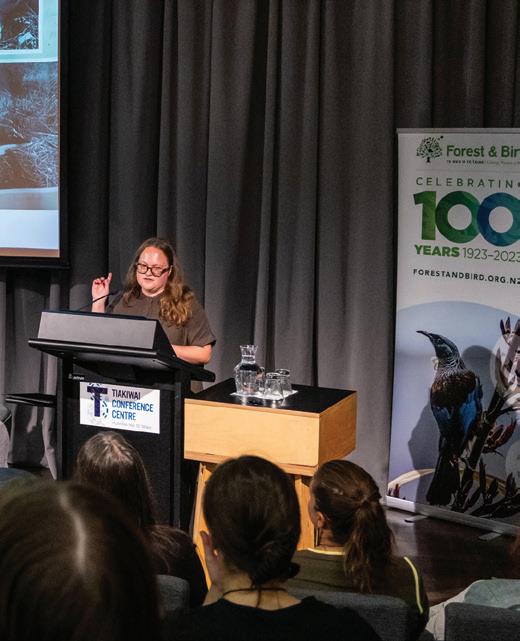
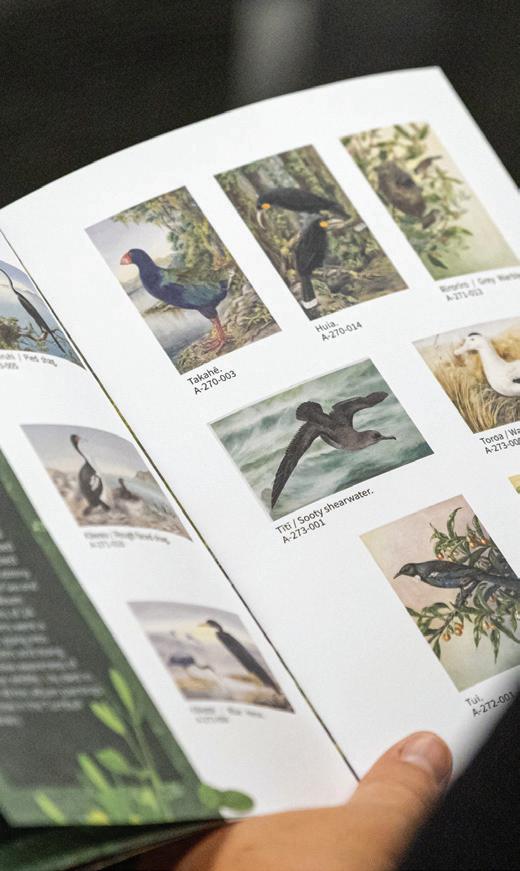
37 Tukutuku Kōrero 8 April 2024
In 1929, Forest & Bird commissioned Lily Daff to paint 52 watercolour paintings of New Zealand birds in their native habitats.
Apryl Morden talking about the contribution of female artists to conservation.
Image: National Library of New Zealand/Mark Beatty.
Empowering equity with refreshed assessment tool
With a legacy spanning more than four decades, Progressive Achievement Tests assessments have undergone a refreshing transformation led by the New Zealand Council for Educational Research, charting a course toward greater equity in education.
Progressive achievement tests (PATs) remain a popular assessment for schools. Established more than 40 years ago, they are a useful tool for schools to use alongside other data sources to understand how ākonga are progressing.
Since 2021, the New Zealand Council for Educational Research (NZCER) – creator and administrator of the PATs – has been undertaking a refresh of the tests as part of a journey to make assessment more equitable for ākonga.
While the work is far from complete, there have been several big changes in the last year that can be hugely beneficial for schools.
What are PATs?
PATs are a suite of standardised assessments developed by NZCER, specifically for learners in Years 3–10 (although some refreshed assessments are also appropriate for Year 11).
These assessments are research-based and have been carefully developed for use in Aotearoa New Zealand English-medium contexts. Each assessment can be used at multiple year levels and achievement is reported on a common measurement scale, which is currently being updated across each refreshed assessment.
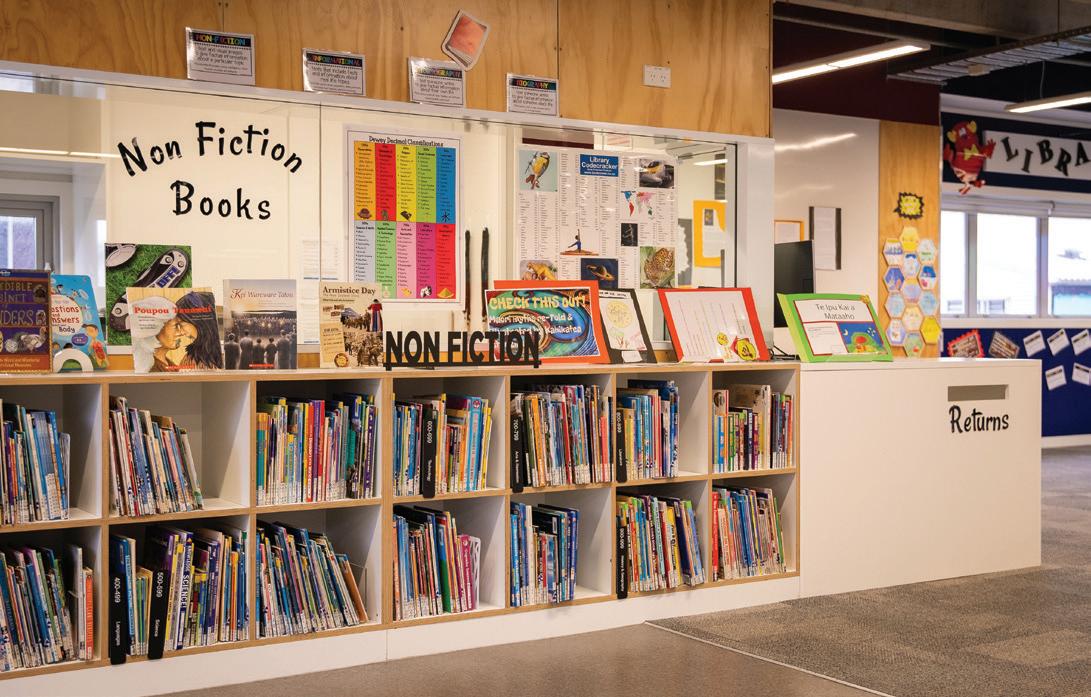
38 Education Gazette gazette.education.govt.nz
ASSESSMENT
Read this article online for more information about what the refreshed assessments look like.
PAT Pānui | PAT Reading Comprehension, the latest of the updated assessments, is now available online.
Currently, NZCER offers the following in both paper format and digital format (unless otherwise noted):
» PAT Pāngarau | PAT Mathematics, a refreshed assessment for Years 3–10
» PAT Pānui | PAT Reading Comprehension, a refreshed assessment (digital-only in 2024)
» PAT: Reading Comprehension (not refreshed)
» PAT: Reading Vocabulary (not refreshed)
» PAT: Listening Comprehension (not refreshed)
» PAT: Punctuation and Grammar (not refreshed)
“[PATs] provide a useful snapshot, a point-in-time measure of how ākonga are doing that can support in- and out-ofclassroom conversations,” says NZCER tumuaki Graeme Cosslett.
“There is always scope for improvement in the assessment space, which is why we decided a few years ago to embark on this equity-focused journey … It is important to us, as well as the schools and sector bodies we regularly speak to, that we really give attention to the equity focus in our assessments.”
What does equitable mean?
In an equitable system, it’s recognised that some people are advantaged compared with others, and resourcing or pathways are provided so those without advantages can succeed.
“We know from the evidence that in Aotearoa, a disproportionate number of ākonga Māori, Pacific learners, ākonga from low socioeconomic backgrounds, and ākonga with additional needs achieve at significantly lower levels than their peers,” notes Bronwyn Gibbs, kaiwhakawhanake rauemi matua/kairangahau | senior resource developer/researcher.
“Assessment practices and differences in opportunities for learning have contributed to these inequitable outcomes. The PAT refresh is about changing these to help address those outcomes.”
Bronwyn adds that kaiako should ideally engage with multiple sources of assessment data, not just the PATs.
By providing all ākonga with opportunities to build on their languages, cultures, and identities as strengths, they can reach their full potential as learners.
PATs in the current environment
Dr Charles Darr, kaihautū rangahau at NZCER, believes that assessment tools such as the PATs have an important role to play in measuring student progress – but they should be used as one of many tools to support ākonga through their education.
“These assessments are a fantastic tool for measuring progress – but they should be used in a low stakes environment and in concert with other measures, as well as in collaboration with whānau and community. They should not be a standalone indicator of how kaiako are progressing.”
Charles says other measures can include classroom observations and learning conversations, collecting ākonga work samples, conducting ākonga self and peer assessments, or using assessment tools created by kaiako.
It is by building this more comprehensive and holistic picture of ākonga progress, he says, that we can better support learners to flourish.
The refresh is intended to make these assessments more culturally relevant, authentic and accessible for all ākonga, and this work will continue in the years ahead.
All of the new assessments have been rigorously tested and piloted with schools to ensure continuity between the previous PATs and the refreshed ones.
“[PATs] provide a useful snapshot, a point-in-time measure of how ākonga are doing that can support in- and out-of-classroom conversations.”
Graeme Cosslett

How did your audit go?
Let the school accounting professionals take the worry and hassle out of the audit process
Financial Reporting
Education Services provides a Financial Reporting Service to over 700 Schools.
EdCloud - Real time dashboard/reporting and enquiry functions. Software made specifically for New Zealand Schools. Reduce the risk of misappropriation and fraud by using our creditor payment service which includes a third party bank account verification.
We are the Financial Reporting Specialists. We would be delighted to provide you with a peace of mind solution to all of your Financial Reporting needs.
No software needed at the School, all reports, ledger, queries, creditor schedules etc through the cloud 24/7 and we train your staff.
We are a xero partner – or use our own school specific software the choice is yours
For a no-obligation quote please contact: Pete on 06 757 5489 or pete@educationservices.co.nz
Education Services has seven offices that service Schools anywhere in the North Island.
Property Service
We provide long term maintenance plans and project supervision in the Taranaki, Whanganui and Manawatu regions.
For more information contact: Mel on 06 349 06902
www.educationservices.co.nz
39 Tukutuku Kōrero 8 April 2024
YEARS 1924 2024
CELEBRATING OF SCHOOL BUSES
pril Fools’ Day is probably not the most auspicious day to start a whole new way of travelling to school in Aotearoa, but back in 1924, it was a day hotly anticipated by ākonga in the Piopio area.
At the turn of the 19th century, many of our rural schools across the motu were extremely isolated, and most consisted of just the one room and teacher. These schools had trouble recruiting qualified teachers who were willing to live in such isolated places. In addition, the cost of maintaining all of these tiny schools and their equipment was exorbitant.
The then Department of Education had a plan to solve these issues: consolidation. This meant merging smaller schools to create one larger school. However, for this plan to work, they had to be able to get the children to the new school.
Piopio (King Country) was chosen as a pilot location and the Department set up Aotearoa’s first school bus fleet (comprised of three Model T Ford buses) to take ākonga from Te Mapara, Paemako and Arapae

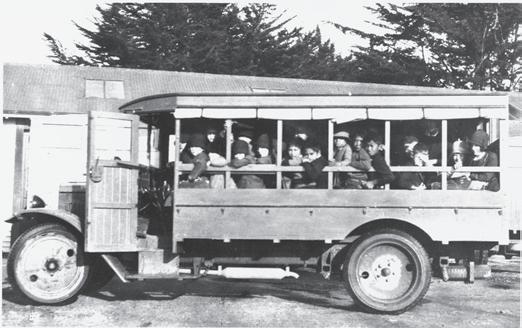
to the new school in Piopio. The buses were delivered to Piopio on 26 March and went into service on 1 April 1924.
This new way of taking children to the school, rather than locating the school near the children, turned out to be a major triumph.
Further successful consolidation schemes in Tapawera (Nelson) and Ruawai (Northland) paved the way to school buses becoming part of the fabric of school life.
100 years later, the Ministry still plays an important role in getting ākonga to school. Every day the Ministry assists over 100,000 ākonga by providing school buses, conveyance allowances and a specialised school transport service (for those ākonga who have safety and mobility needs).

 Images supplied from the Alexander Turnball Library
School children on board a Department of Education Morris Commercial bus taken circa 1927. PAColl-2647-027
Children boarding a Department of Education school bus, probably travelling between Paemako and Piopio School. 1/1-004539-F
Images supplied from the Alexander Turnball Library
School children on board a Department of Education Morris Commercial bus taken circa 1927. PAColl-2647-027
Children boarding a Department of Education school bus, probably travelling between Paemako and Piopio School. 1/1-004539-F
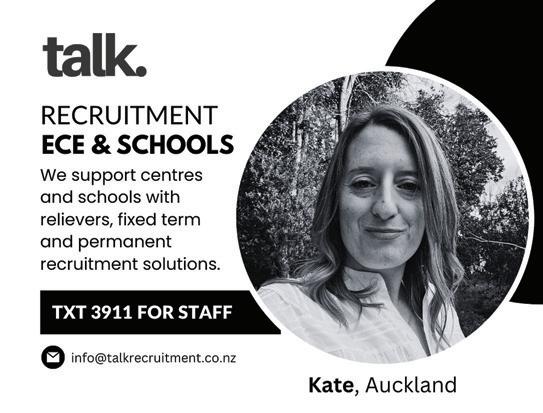
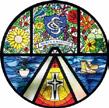
Our
St Catherine’s College, Wellington Principal / Tumuaki
St Catherine’s College, Wellington Principal / Tumuaki
Integrated multicultural Catholic Girls School Y9-13,
Integrated multicultural Catholic Girls’ School Y9-13, U4
is to nurture and empower young
St Catherine’s College is a small school with a big heart and even bigger potential.
to become active and creative learners equipped with skills and strong Catholic values of mercy, wisdom and social justice. Are you an ambitious leader who
Our vision is to nurture and empower young women to become active and creative learners, equipped with skills and strong Catholic values of mercy, wisdom and social justice.
Are you an ambitious leader who is ready to do the mahi and make our school the first choice for Catholic girls in Wellington? We aim to become the greatest little college in the Capital city.
You will be an an outstanding leader who will strive for excellence in education and be a role model for our vibrant and diverse school whānau. You will prepare our rangatahi for the future and motivate them to take pride in their college and to be the best they can be.
You will put the principles of Te Tiriti o Waitangi into practice as we continue our work to ensure Māori students achieve as Māori and all students leave our school as exceptional Treaty partners. As a visionary and inspirational leader of staff, you will demonstrate a thorough understanding of current approaches to effective teaching and learning. A willingness and ability to participate in the religious instruction appropriate to the Special Character of the school is a condition of employment.
For more information, see https://www.stcatherinescollege. school.nz/ and email Chris Perry at applications@scc.school.nz for an application pack.
Applications close at 12 noon Monday 15 April 2024.


RECRUITMENT 41 Tukutuku Kōrero 8 April 2024
Tēnā koe, talofa, kumusta
U4, Decile 6
is ready to do the mahi and make our school the first choice for Catholic girls in Wellington? We aim to become the greatest little college in the Capital city. You will be an an outstanding leader who will strive for excellence in education and be a role model for our vibrant and diverse school whānau. You will prepare our rangatahi for the future and motivate them to take pride in their college and to be the best they can be. You will put the principles of Te Tiriti o Waitangi into practice as we continue our work to ensure Māori students achieve as Māori and all students leave our school as exceptional Treaty partners. As a visionary and inspirational leader of staff, you will demonstrate a thorough understanding of current approaches to effective teaching and learning. A willingness and ability to participate in the religious instruction appropriate to the Special Character of the school is a condition of employment. For more information, see www.stcatherinescollege.school.nz/ and email chris.perry@scc.school.nz for an application pack. Applications close on Sunday, 10 January 2021. ST CATHERINE’S COLLEGE www.stcatherinescollege.school.nz 04 9398988 SENIOR LEADERSHIP 7-15 Vacancies Notices Professional learning and development View PLD, general notice listings and vacancies at gazette.education.govt.nz Do you have a vacancy that you would like to advertise to the education sector? Place an advertisement in the vacancies section and reach both the passive and active jobseekers by contacting Jill Parker: jill.parker@nzme.co.nz 027 212 9277
Tēnā koe, talofa, kumusta. St Catherine’s College is a small school with a big heart and even bigger potential.
vision
women
Launches 1 May


Join Hector and friends for online safety adventures – coming soon!
Hector’s World is back to help tamariki navigate the online world safely in a new series of educational videos. Supported by the Ministry of Education, Netsafe have revamped the Hector’s World programme to address the contemporary online challenges children face.
How Hector’s World helps young ākonga safely use the internet
In Hector’s World our hero characters are empowered to make responsible choices when faced with online challenges like cyberbullying, mis/disinformation, digital footprints and privacy. Feedback from kura has informed the development of seven fun
and thought-provoking episodes. Created for primary-aged children, each episode is supported by a wide range of resources and lesson plans targeted for year groups 1-3 and 4-6. Hector’s World aligns with the Ministry of Education’s curriculum and learning outcomes across Health, Physical Education and Technology. The programme includes take-home activity packs to help shape conversations with parents and whānau, to support ongoing education. This recognises the strong links between the classroom and home to embed learning to become well-equipped digital citizens.
Schools can dive into Hector’s World soon –with the launch on 1 May!
Get your planning pack now!
Learn more about Hector’s World and how to integrate learning resources into your school curriculum by downloading a planning pack at: education.netsafe.org.nz























 Harata in her zone, sharing her expertise on te reo Māori and tikanga Māori.
Harata in her zone, sharing her expertise on te reo Māori and tikanga Māori.




































 Heinrich, Year 13 at St Bede’s College and Nina Oberg Humphries, sponsor of this year’s Measina Creative Award.
Heinrich, Year 13 at St Bede’s College and Nina Oberg Humphries, sponsor of this year’s Measina Creative Award.














 Images supplied from the Alexander Turnball Library
School children on board a Department of Education Morris Commercial bus taken circa 1927. PAColl-2647-027
Children boarding a Department of Education school bus, probably travelling between Paemako and Piopio School. 1/1-004539-F
Images supplied from the Alexander Turnball Library
School children on board a Department of Education Morris Commercial bus taken circa 1927. PAColl-2647-027
Children boarding a Department of Education school bus, probably travelling between Paemako and Piopio School. 1/1-004539-F







